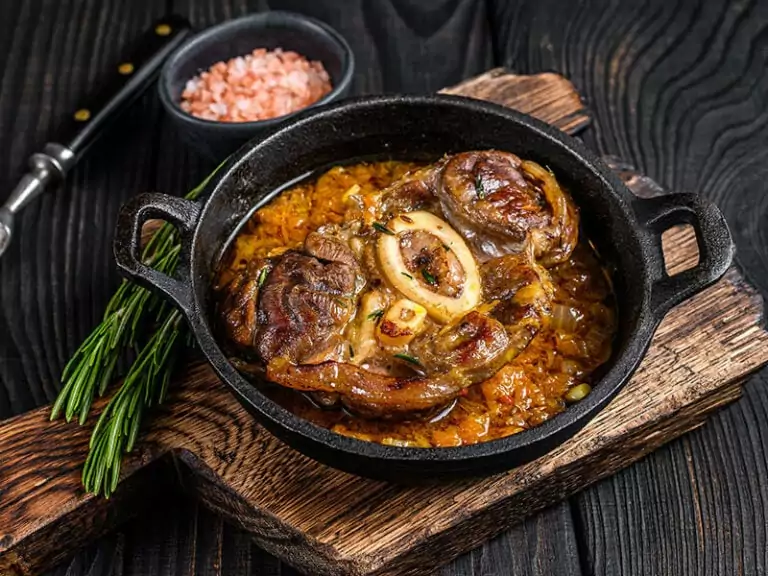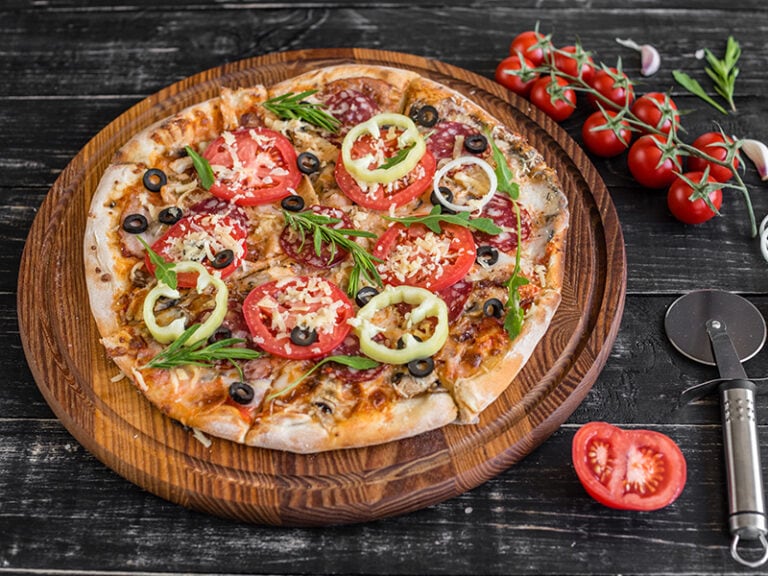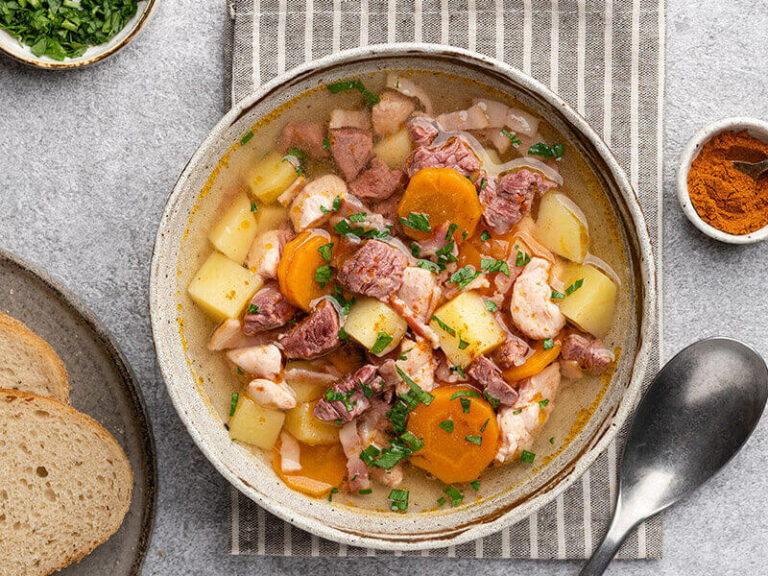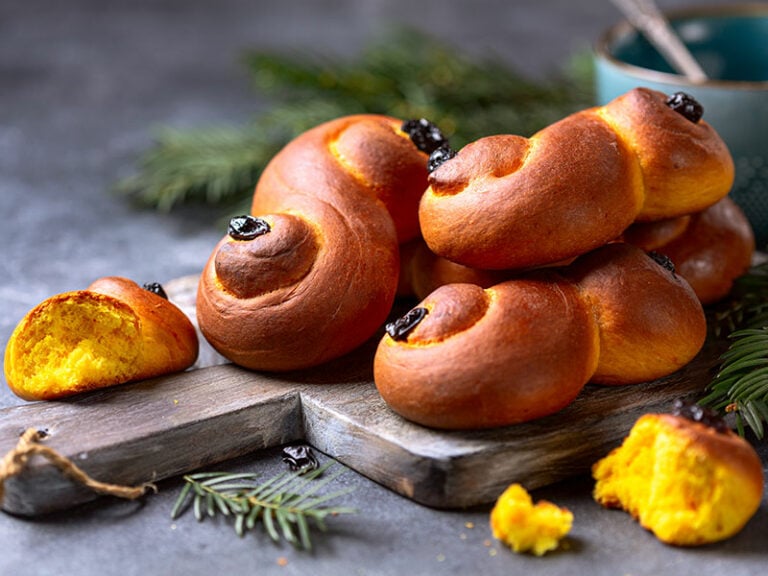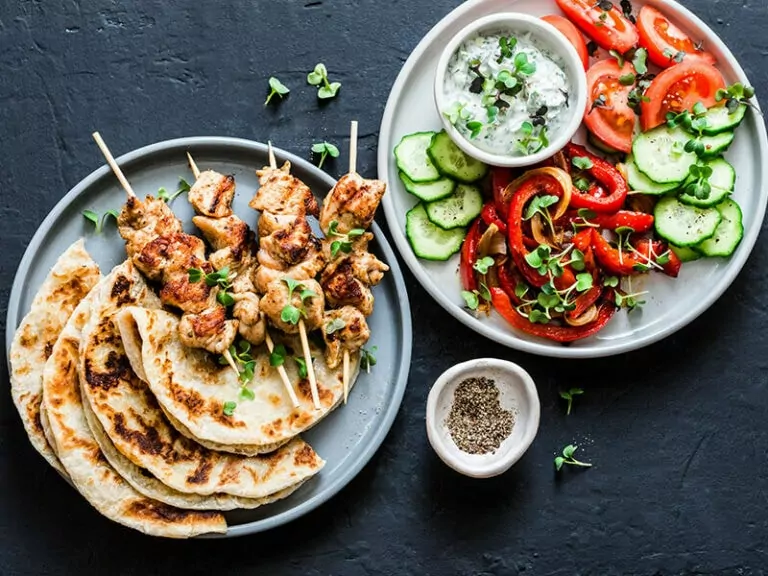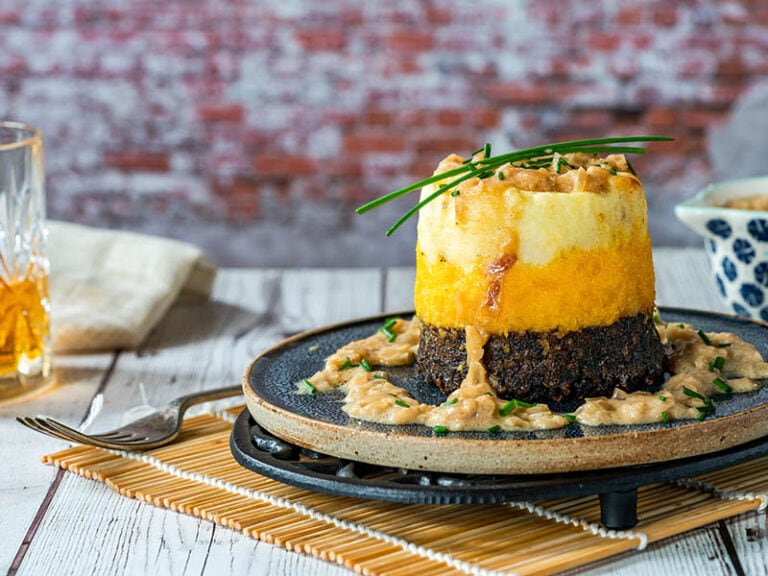Craving a delectable escape to the vibrant European street food? Let’s dig into this adventure with these delights. From sizzling sausages in Germany to crispy churros in Spain, these culinary delights are ready to whisk you away on a wonderful journey of flavors.
Here, you can discover the secrets of authentic European cuisine, expand your culinary horizons, and satisfy your wanderlust without leaving your kitchen. So prepare to be transported to the bustling streets of Europe with every delicious bite.
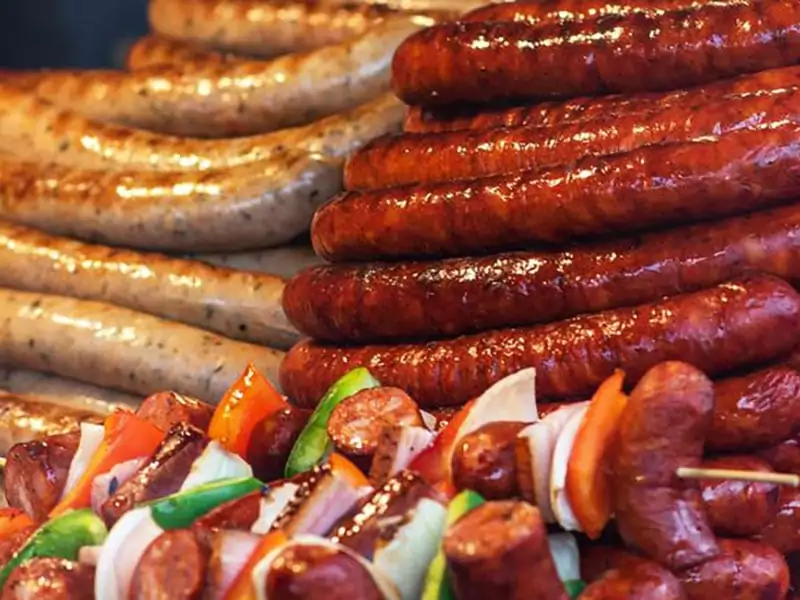
The Overview Of The Street Food In Europe
European street foods reflect the continent’s rich and varied cultural heritage. These edible delights are an excellent gateway to understanding European cultures.
In Western Europe cuisine, the quintessential French crêpes with sweet and savory fillings or the classic German Bratwurst served hot from the grill are integral to the culinary identity.
Venturing into Eastern Europe delicacy, one can indulge in Poland’s Zapiekanka, an open-faced baguette sandwich topped with mushrooms, cheese, and ketchup. Another choice is Russian Pirozhki, small buns filled with a variety of ingredients, from seasoned meat to tangy fruits.
Central Europe’s fascinating culinary narrative is showcased aptly by Lángos in Hungary, a deep-fried flatbread with sour cream and cheese. You can also experience it in the Czech Republic’s Trdelník, a sweet pastry delicately rolled around a stick and grilled to perfection.
Classic Southern European fare boats a unique combination of flavors that will captivate your taste buds. Italian pizza al taglio (pizza by the slice) and Greek Souvlaki (skewered grilled meat) are globally famous street foods.
Further north, the British icon fish and chips, and Swedish cinnamon buns Kanelbulle, are mouth-watering additions to European street food markets as emblematic Northern European delicacies.
These dishes not only provide a taste of their respective countries’ gastronomic culture and evoke a sense of comfort and familiarity among locals and travelers.
In Portugal
1. Bacalhau (Portuguese Salt Cod)

Bacalhau (dried and salted codfish) has a significant place in the list of heritage Portuguese dishes. Strolling through the bustling streets of Portugal, I see it in nearly every store. It is also extremely versatile, appearing in more than 365 different recipes of many kinds, a fact that never ceases to amaze me.
My favorite dishes with this seafood are Pataniscas de Bacalhau (salt codfish cakes) and Pasteis de Bacalhau (salt codfish fritters).
But other recipes like Bacalhau à Brás (salt codfish, potatoes & egg), Bacalhau à Gomes de Sá (salt cod, onions, and potatoes), Bolinhos de Bacalhau (salt cod croquettes), Bacalhau à Zé do Pipo (shepherd’s pie with salt cod) are also my cup of tea.
2. Bifana (Portuguese Pork Sandwiches)
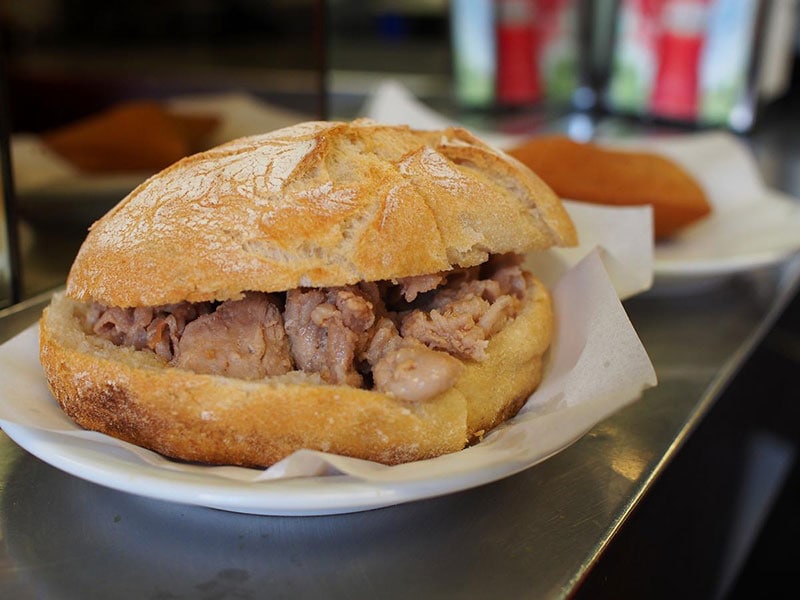
This classic sandwich is available in many restaurants and is also considered one of the most popular Portuguese street foods. At the heart of the sandwich is a juicy pork steak that can be sliced, lightly pounded, or left whole.
After being marinated with a mix of spices, garlic, and white wine, it is roasted until fragrant and succulent before being tucked into a crusty bread roll. Up north, locals characterize their Bifana by simmering the meat in a spicy broth, which they also drizzle onto the bread.
In the south and Lisbon, you might find your sandwich topped with yellow mustard, although Bifana traditionally requires no other condiment. In terms of sides, pair it with dishes like French fries, caramelized onions, and garlic for the complete Portuguese bar experience.
3. Francesinha (Portuguese Sandwich)
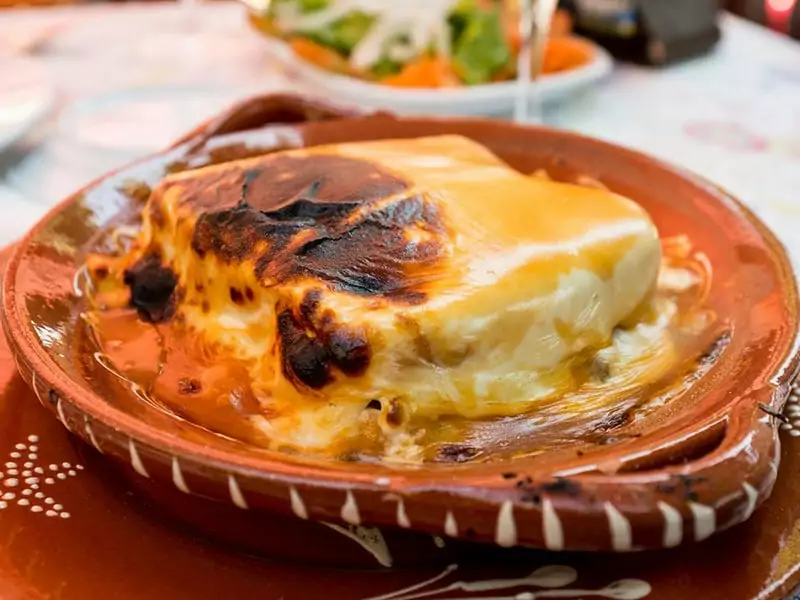
Francesinha is a culinary masterpiece from Porto. It consists of wet-cured ham, chipolata sausage, and roast meat stacked between slices of white bread.
The meaty sandwich is then elegantly cloaked in melted cheese, doused with a hot tomato and beer sauce, and finally topped off with an egg. Served with fries, Francesinha offers a truly hearty and satisfying meal.
4. Pastél de Nata (Portuguese Custard Tarts)
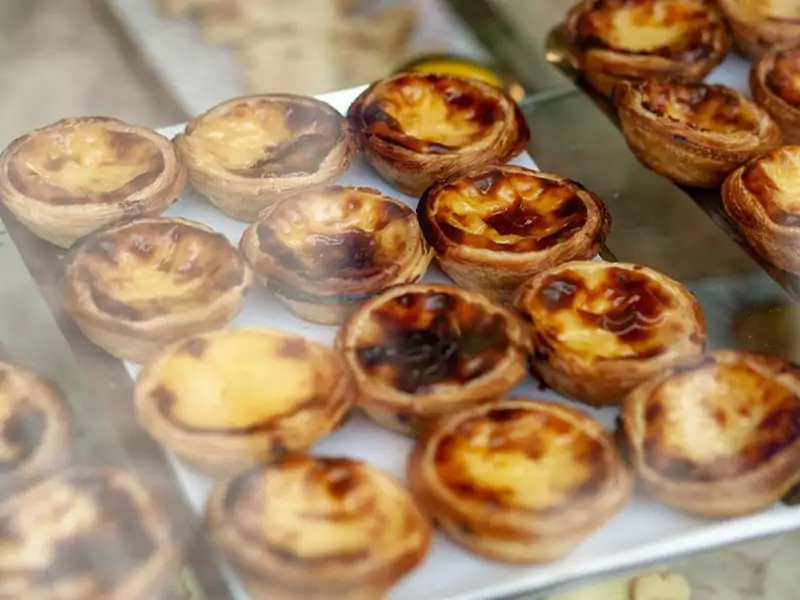
Every bite into a Pastél de Nata takes me back to its history. These buttery egg custard tarts date back to 1837, thanks to a recipe created by the Jerónimos monastery. They were once dubbed Pastel de Belém, but this name is now reserved for tarts baked at the Fábrica Pastéis de Belém [1].
A Pastél de Nata consists of a pastry shell stuffed with a custard filling, which is a blend of milk, eggs, sugar, lemon, and cinnamon. Its slightly burnt top adds an unexpected bitter twist to the rich flavor. Pair it with coffee or bagaço (a Portuguese wine brandy), and the indulgence is complete.
In Spain
5. Tapas
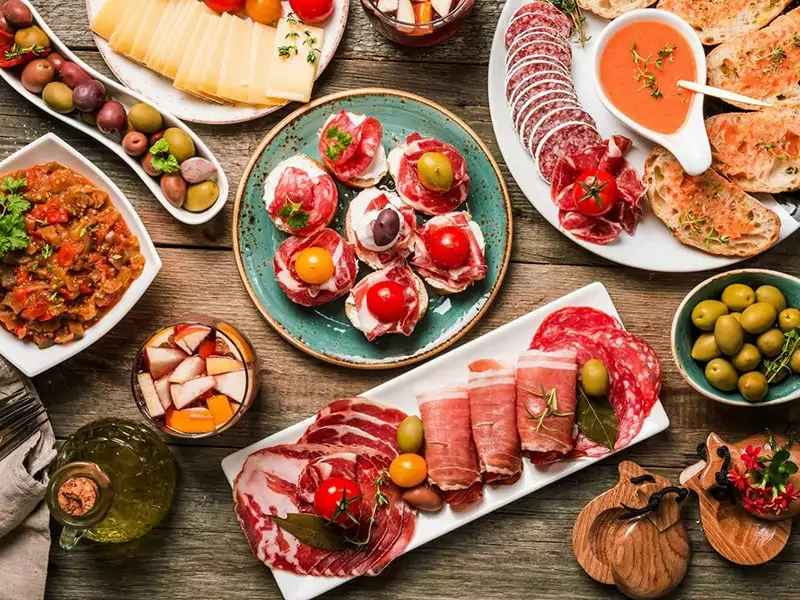
For me, it is a crime to visit Spain without trying tapas, its popular appetizers. From the northern Basque region, where locals call them Pintxos, to the bustling streets of Madrid, these bite-sized delights have been a constant source of culinary pleasure.
They come in many recipes, but the main categories are meat, fish, or vegetable-based bites. All can be served hot or cold, with a toothpick as a necessary tool to pick them up.
My favorite dishes are Patatas Bravas (flash-fried white potatoes with spicy tomato sauce), Tortilla de Patata (Spanish omelet), and Bombas (deep-fried potato balls with a meaty filling).
Whether it is in an upscale restaurant, a dedicated tapa bar, or a local street food stall, these dishes always bring Spain’s vibrant culture to life for me.
6. Empanadas
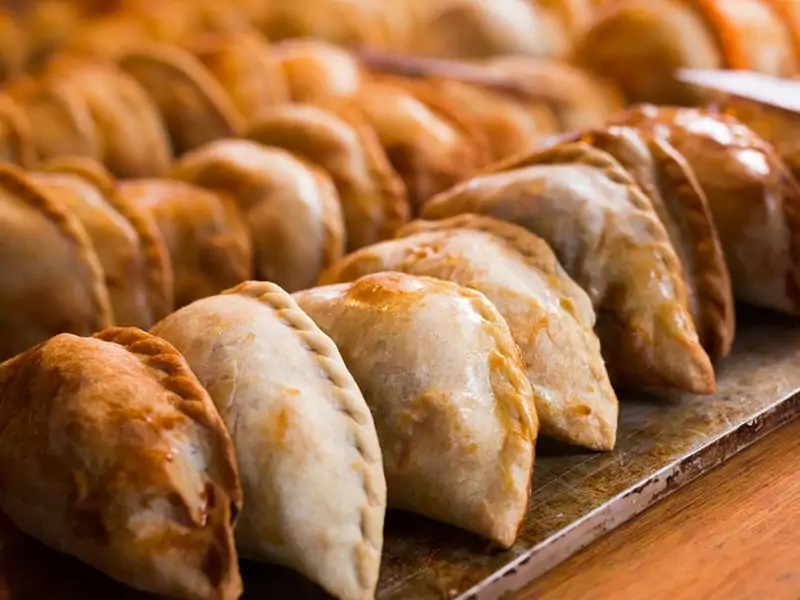
From Galicia, empanadas are now a famous appetizer, snack, entree, and street food in Spain as well as many Spanish-speaking countries. Their first mention dates back to a 1500s cookbook, and their popularity.
The name “empanadas” speaks to their nature – a Spanish phrase meaning “covered with bread” or “breaded.” It is a fitting description for these flaky, crescent-shaped pastries, which look like Indian samosas.
They are generously filled with many ingredients, such as spiced meats, cheese, fruits, or vegetables, or even potatoes, before being baked or deep-fried. Sauces like ketchup, mayonnaise, or mustard are the perfect condiments to complement their rich and savory goodness.
While Latin American empanadas are a league of their own, my favorite hunting grounds are Barcelona and Madrid. Their variety of empanadas is just mind-boggling.
7. Bocadillos (Spanish Sandwich)
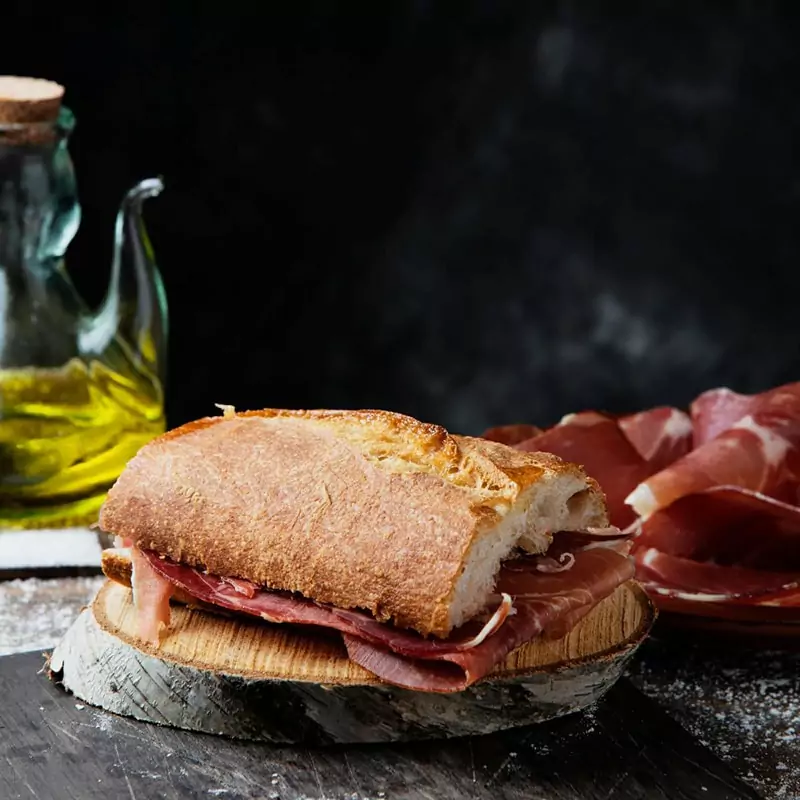
This Spanish sandwich is a lunch staple in the country. With rustic, baguette-like bread or tortillas as the base, it is stuffed with energy-rich ingredients like roast beef, ham, chicken, or pork. Cheese, tuna, potatoes, and eggs are other enticing options.
Nowadays, there are many vegan and vegetarian Bocadillos versions for people who need them. To heighten the flavors, both meaty and plant-based versions demand condiments like mustard, ketchup, tomato sauce, or mayonnaise.
Pair it with beer, wine, or coffee, and you will have a complete, satisfying meal. It’s no wonder all Spanish tapas bars, cafes, and restaurants happily serve them.
8. Churros
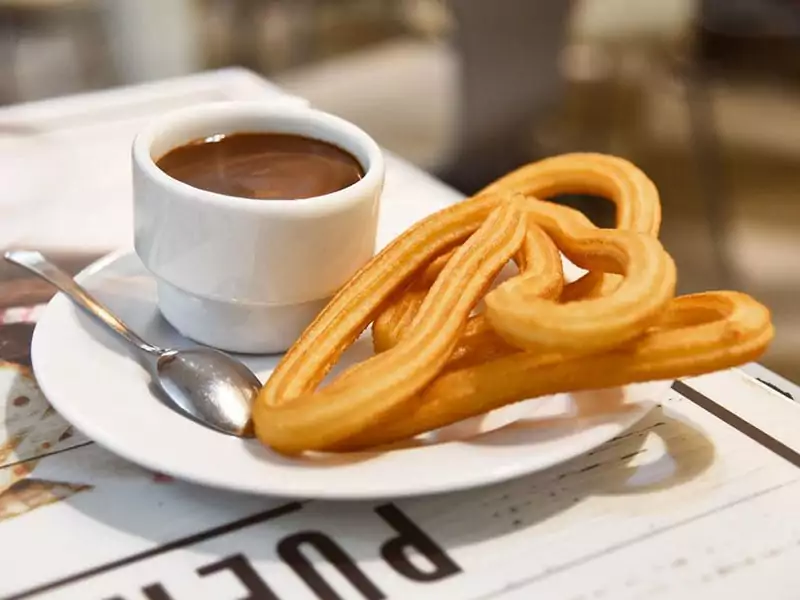
Churros are a product of Spanish and Moorish shepherds’ creativity. However, there is a theory saying that they might have been inspired by Chinese deep-fried dough. Churros are a breakfast favorite in Spain and Latin America.
They consist of deep-fried yeast dough, sprinkled with cinnamon sugar. The crispness and sweetness make them ideal for morning coffee or hot chocolate.
In Italy
9. Gelato

One of Italy’s most famous and flavorful masterpieces to the world is the magnificent gelato. Many people believe it originated in the Middle Ages in Florence. This refreshing frozen dessert variety is an Italian take on ice cream. It has a higher milk content and fewer eggs than its counterparts, resulting in a softer and silkier texture.
In addition, churning at a slower pace reduces air incorporation in gelato, further enhancing its texture. Locals often serve the dessert a bit warmer than most frozen treats. During my travels through Italy, from Turin to Sicily, I was always greeted by the sight of gelato at street food stalls.
I particularly loved the local Sicilian version: Brioche con gelato (gelato served inside a brioche bun). It is a superb snack and breakfast dish, which you can devour like an ice cream sandwich or more elegantly with a spoon.
10. Zeppole (Italian Doughnuts / Donuts)
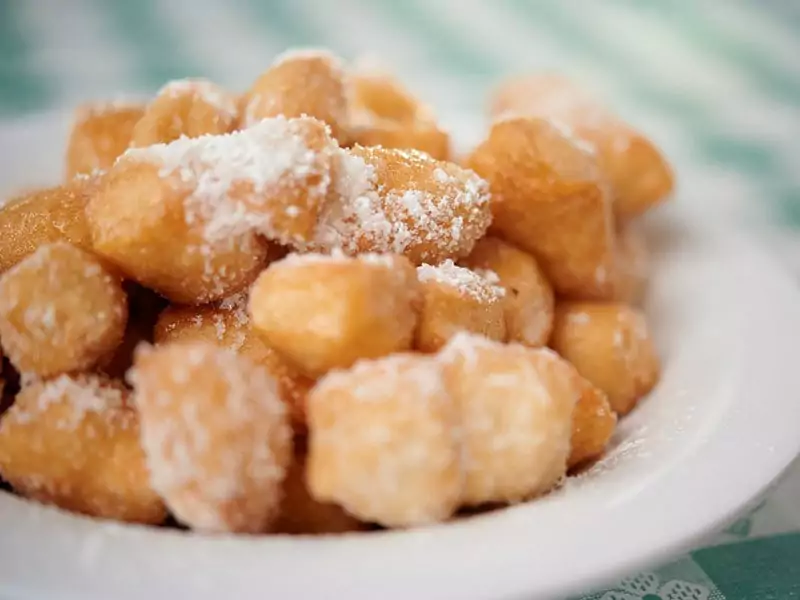
Hailing from Naples, Zeppole are delicious deep-fried dough balls I have enjoyed on many occasions. They are filled with cream, chocolate, custard, or jelly. But the topping is no less awesome: powdered sugar, butter, honey, or more custard and jelly.
The doughnut is widely available as an on-the-go street food in Italy at most bakeries and carnivals. The combo of Zeppole and cappuccino is my favorite.
11. Cannoli

Named after the Italian word “canna,” cannoli is a beautiful creation from Palermo. This cylinder pastry has been around since the time of the Emirate of Sicily. It was originally created for Carnevale celebrations.
Cannoli combines a crispy shell with whipped ricotta cream. Bite into one, and the flavors of Marsala wine, candied fruit, coffee, and chocolate chips will greet my palate. On Lipari island, there is a version made with pistachio and preserved lemons.
While cannoli is already sweet, it is often sprinkled with powdered sugar. It is an addictive street food you can find at street vendors, bakeries, and cafes. And remember to have napkins nearby when you eat a cannoli: it’s deliciously messy!
12. Lampredotto (Tripe Sandwich)
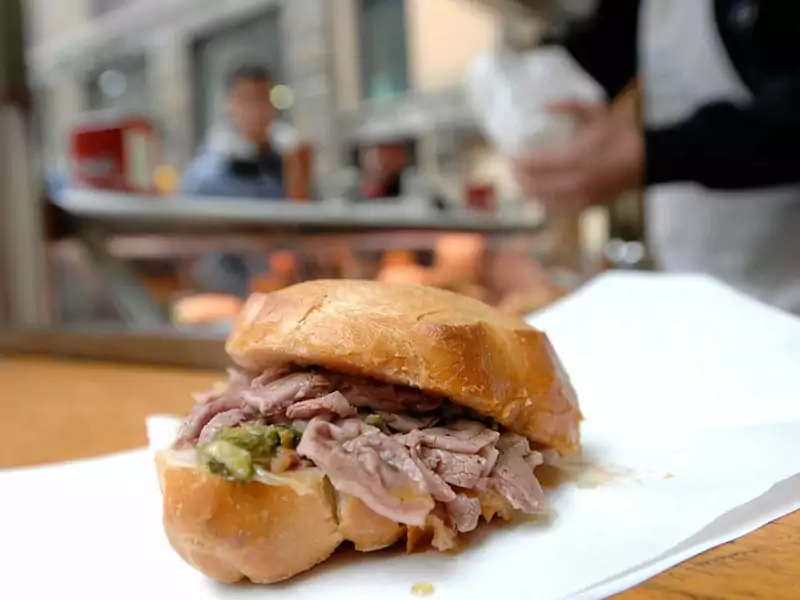
From the heart of Florence comes Lampredotto. This exquisite delicacy consists of the abomasum (the fourth stomach of a cow) slow-cooked in a flavorful broth along with a medley of vegetables. The robust flavors are further enhanced with salt and pepper.
The last step is to put everything into a crispy bun and top with a tangy salsa verde. It is absolutely delicious, though some people may need an adventurous spirit to taste it.
Piadina (Italian Flatbread)
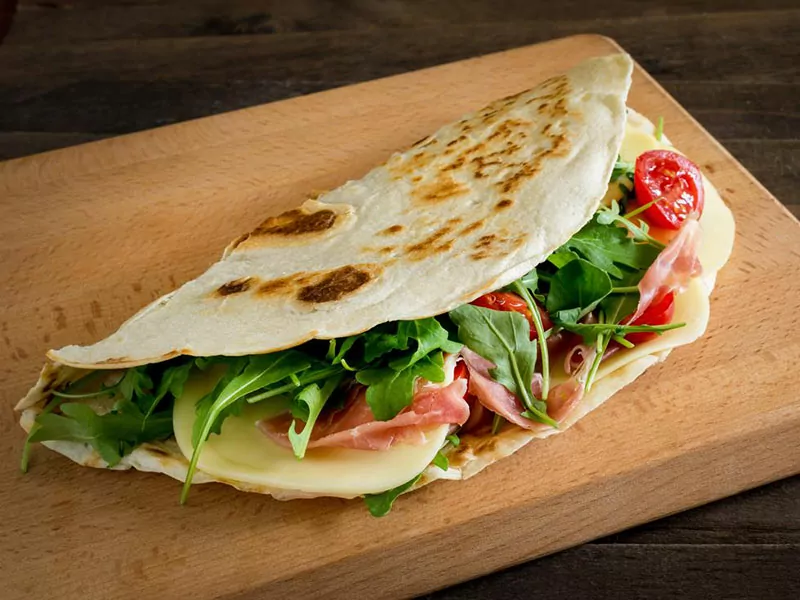
In the bustling street markets of northern Italy, one type of flat feet completely has my heart: Piadina. This Italian bread type is made of white flour, olive oil, salt, and water and is cooked on a terracotta plate or griddle. Besides the starchy sweetness, Piadina also offers subtle notes of olive oil.
Thicker than a tortilla yet thinner than pita bread, the flatbread is a perfect sandwich wrap. It can be stuffed with things like soft cheeses (like mozzarella or gorgonzola), cold cuts (such as salami or Prosciutto di Parma), and fresh veggies (like tomatoes or wild arugula).
Fruits like figs sometimes make an appearance too. For those with a sweet tooth, Piadina transforms into a dessert, with the addition of jam or Nutella.
The famous Piadina Romagnola, which originated from Romagna and is made with maize flour, is a famous variety. It boasts the EU-granted Protected Geographical Indication (PGI) status, an interesting upgrade from its original status as a poor man’s food.
Panzerotti (Italian Hot Pockets)
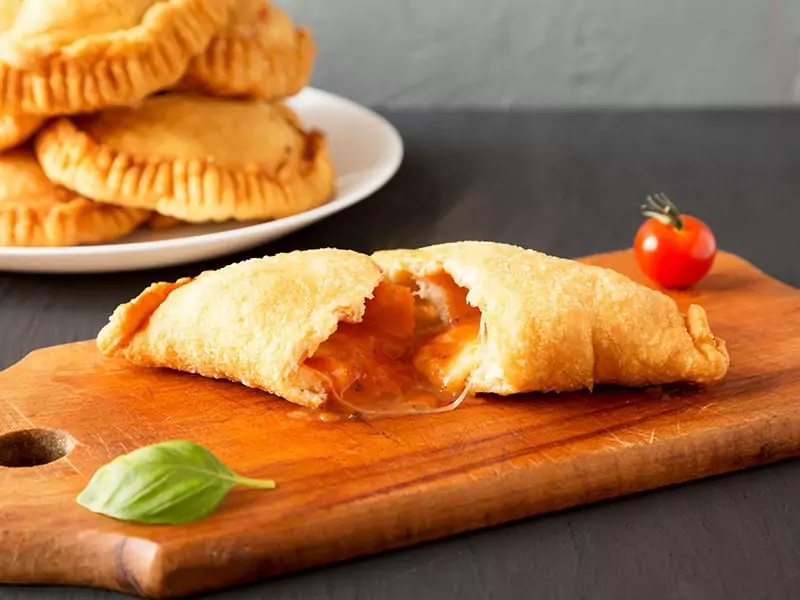
The first Panzerotti was born beneath the sun-kissed skies of the Apulia region in the 18th century. It became popular in southern Italy as well as other regions, reaching northward as far as Milan. It has several alternative names, like Calzoni Fritti, Pizze Fritte, or Frittelle.
This crescent-shaped turnover has a close connection to calzones and pizzas, hence the other name. Panzerotti began its journey as a humble Carnevale dish made from leftover bread dough. Today, it is often on the menu of many pizzerias and delis.
Its deep-fried golden crust marks a big difference from its oven-baked relatives. Its interior bursts with classic fillings of tomatoes and mozzarella, while more adventurous versions include other things, like pesto, spinach, zucchini, onions, ham, fontina, etc.
Pani Ca Meusa (Veal Sandwich)
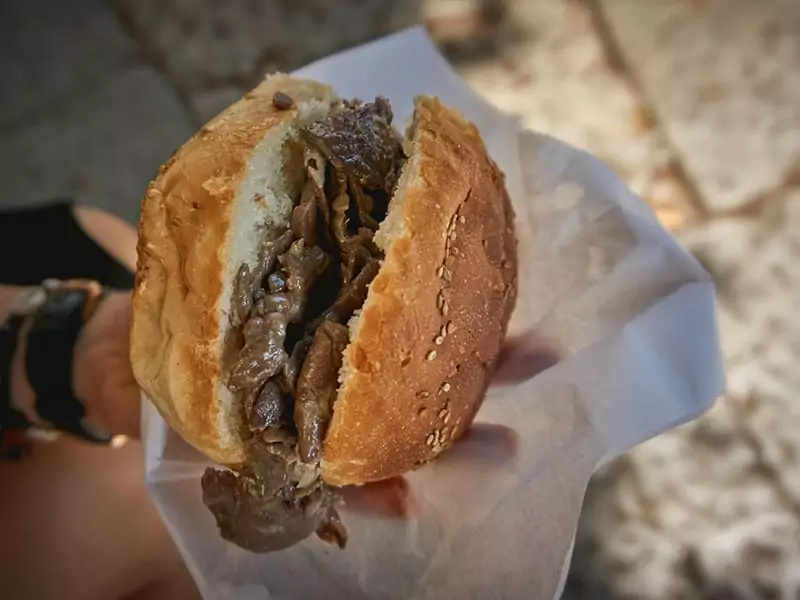
Also known as Panino Con la Milza, Pani Ca Meusa is an exotic staple in Palermo’s and Sicily’s bustling street food scene. This sandwich is a hearty assembly of the veal’s spleen and lungs. After the offals are boiled and fried in lard, they are tucked inside a sesame-topped soft bread bun.
A generous helping of local cheese, be it caciocavallo or ricotta, will complete the recipe. It’s not hard to see why this sandwich, sold by street vendors, holds such a special place in Sicily. Apparently, it originated from the local Hebrew community.
Pesce Fritto Al Cono (Fried Seafoods)
Pesce Fritto Al Cono is a seafood delicacy packed in a paper cone that can be found across Italian coastal towns.
If you come at the right time, you can watch street vendors receive fresh catch from fishing boats during high season, and then skillfully fry it right before your eyes. I love this boat-to-table concept!
Pizza
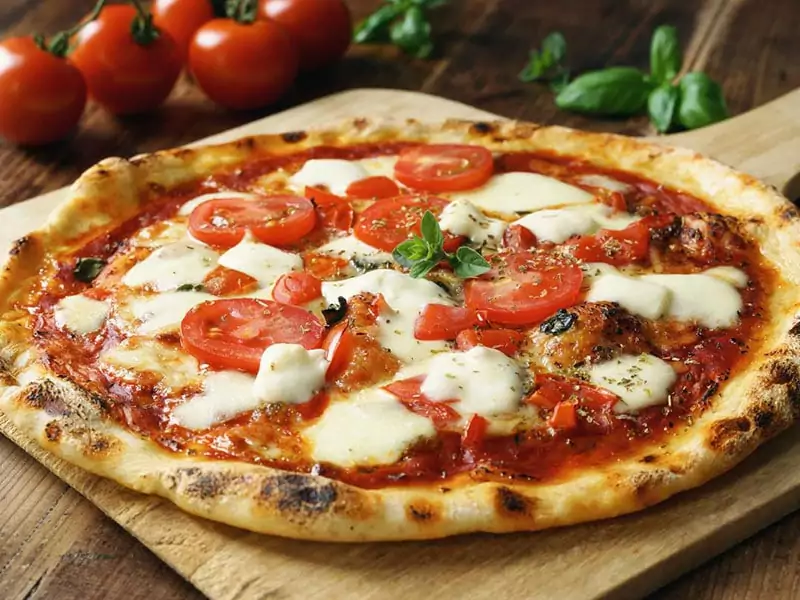
An emblem of Italian gastronomy, pizzas were originally created in the Campania region. Underscoring the rich and diverse chronicle of pizza’s evolution, pizza began as a regional specialty and became a global favorite.
There are numerous pizza varieties throughout Italy, but some are more special than others. An example is the Neapolitan pizzas, which bear the Protected Designation of Origin (DOP) certification.
They differ from mainstream pizzas because of being thin, pliable, and airy. In addition, they boast a 1-inch thick outer crust. Also from Naples is Pizza Capricciosa, whose toppings include artichokes, basil, black olives, cured ham, mozzarella cheese, mushrooms, and tomato sauce.
However, only Margherita and Marinara pizzas are recognized as authentic Italian pizzas thanks to the use of classic toppings. The former was created to honor Queen Margherita in 1889 and carries the colors of the Italian flag with its green basil, red tomatoes, and white mozzarella.
All roads lead to Rome, and so do pizzas. Round pizza tonda (served in sit-down pizzerias) and pizza al taglio (baked on rectangular trays, cut into slices, and sold by weight) are the most popular norms here.
Sfincione (Sicilian Pizza)
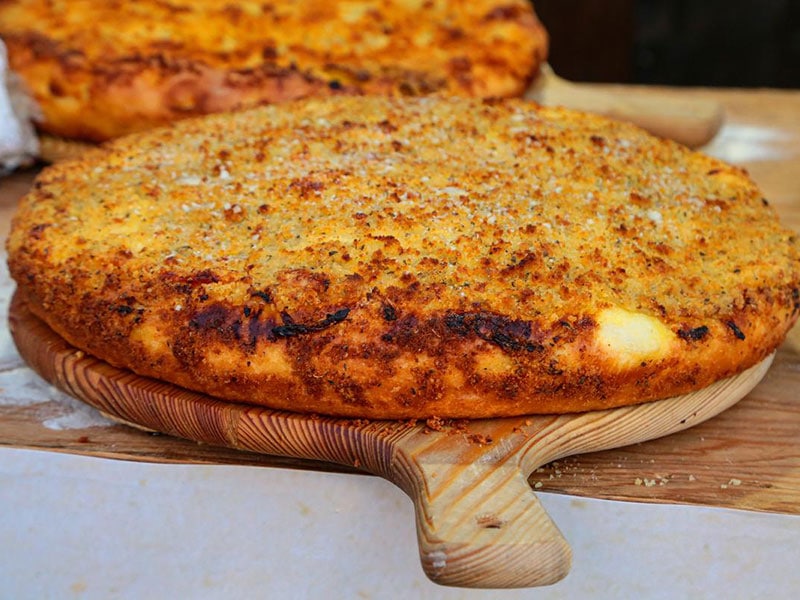
This thick, focaccia-like pizza is a street food wonder from Palermo, Sicily’s capital. Its name, which means “sponge,” nods to the crust’s texture. Popular topping options are local tomatoes, oregano, onions, caciocavallo (a Sicilian sheep’s cheese), and, occasionally, anchovies. This defines the character of Sicilian pizza in its essence.
Sfincione is rather exclusive to Palermo and its nearby towns, but it is a common sight in local street food stalls, bakeries, and pizza shops. It is available throughout the year, especially during the San Giovanni feast and New Year celebrations.
Cacio e Pepe (Pasta With Cheese And Pepper)
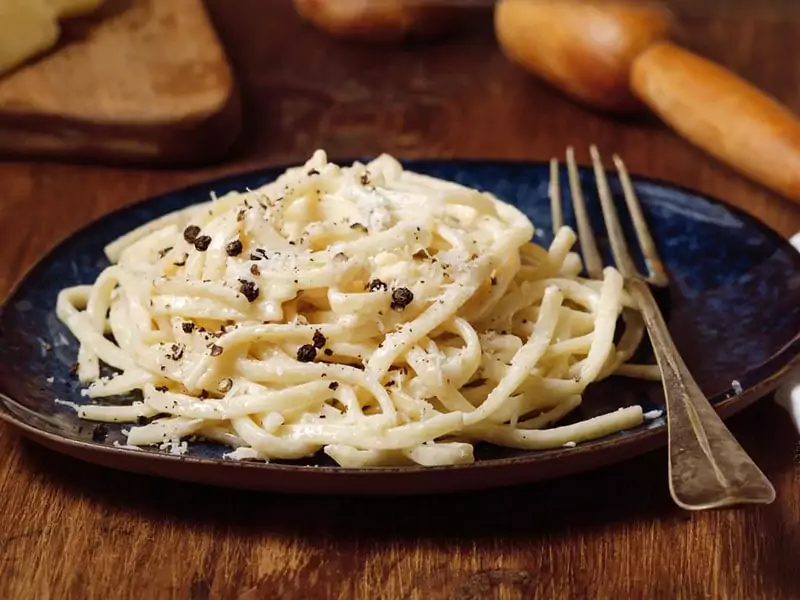
Cacio e Pepe is a simple pasta dish from Italy. It combines pecorino romano cheese (“cacio” in the local dialect) with black peppercorns and pasta water to create a mouthwatering sauce.
Tonnarelli, a thick, square-shaped long noodle, is the other vital ingredient. The secret to perfect consistency lies in using room-temperature cheese and ensuring the water is not too hot so that the sauce will turn out to be a silky blend.
Arancine / Arancini (Stuffed Rice Balls)
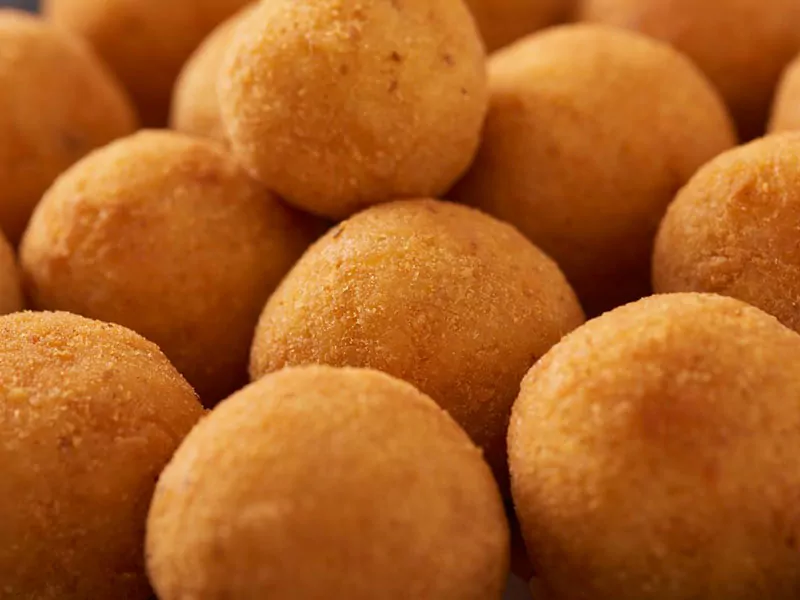
These Italian golden-hued stuffed rice balls come in two different varieties: the round one is called Arancine (the feminine form) in Palermo, and the cone-shaped one (inspired by Mount Etna) is Arancini (the masculine form) in Catania.
Regardless of shape (or gender), both versions get their characteristic color from saffron in the rice mixture. And both are filled with various tasty ingredients, including ragu and mozzarella, before being coated in breadcrumbs and crisped up in hot oil.
In Malta
Hobz Biz Zejt (Maltese Open Sandwich)
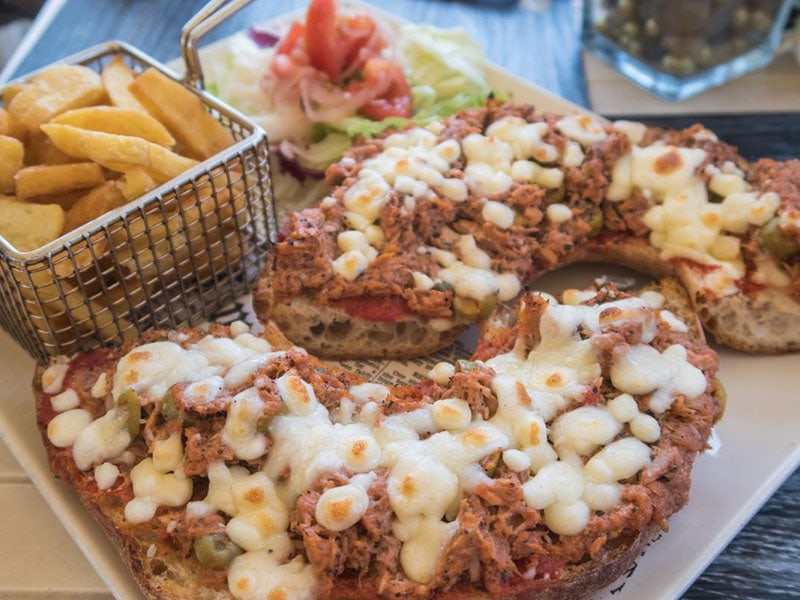
Malta’s cherished “oil bread” is a significant culinary touchstone for me, and enjoying it is a must whenever I have the chance to visit this famous Mediterranean island. Hobz Biz Zejt has rich historical roots, dating back to World War II.
Its base is a sourdough bread roll, filled with a mix of tomato paste, olive oil, olives, capers, and tuna. Additional toppings include sausages, green olives, or green peppers. The sandwich is an excellent pick for a cheap yet satisfying meal, especially when paired with Kinnie (Maltese soft drink).
Pastizzi (Maltese Stuffed Pastries)
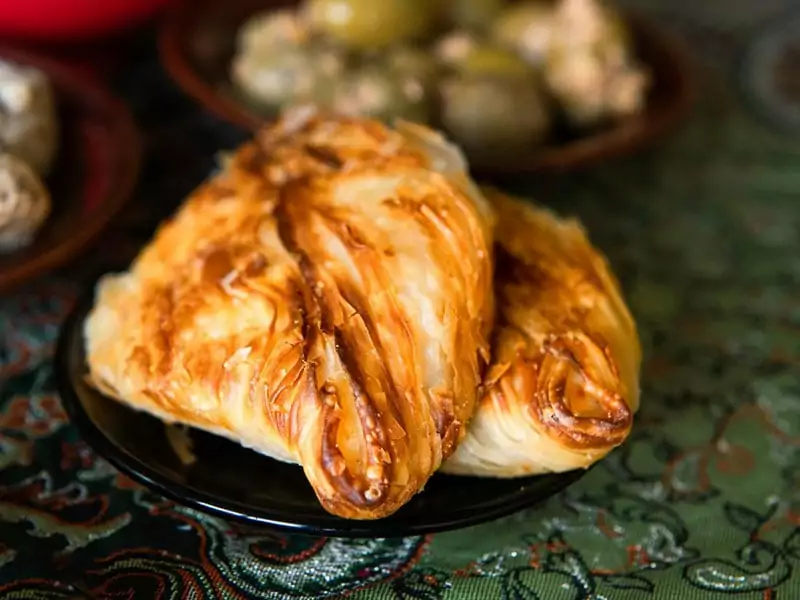
This small, diamond-shaped filo pastry boasts a flaky exterior with butter between layers and a rich filling inside. The common ones are salty ricotta-like cheese or mushy peas, but there are other exciting fillings like spinach, apple, anchovy, or even Nutella.
Special variants filled with spinach and anchovies are a specialty of the Holy Week. You’ll stumble upon all kinds of Pastizzi in pastizzi shops, bars, or supermarkets. From breakfast to beer snacks, or just with mid-morning tea, Pastizzi is a versatile street food delight.
In France
Crepes

Among the most popular street foods in France, crepes fit perfectly into any meal, like breakfast, lunch, or dinner. Sitting at a local crêpe-maker or a food stall, with a crepe in one hand and a coffee in the other, that’s a moment I always cherish.
These paper-thin pancakes come in two categories: sweet and savory. The sweet ones can have chocolate, fruits, or mascarpone cream, and the savory ones offer the satisfaction of ham or cheese.
Croissants

This fantastic French crescent-shaped pastry is famous for its flaky, buttery texture. It can come with sweet or savory fillings. The most popular variants are croissant au beurre (plain butter croissant) and pain au chocolat (chocolate croissant), but there are many other options.
Whether topped with jam, cheese, or ham, croissants are always perfect options for breakfast in France, a midday snack, or the sweet course. From bakeries to food stalls and breakfast buffets, they’re sold almost everywhere, and not just in France.
Despite such widespread fame, its origin is a little bit murky. One theory praises it as a feat of Viennese bakers, while another traces it back to Boulangerie Viennoise, a bakery established by the Austrian officer August Zang.
However, the first croissant recipe appeared in 1906 in the Nouvelle Encyclopédie Culinaire.
Marrons Glacé (Candied Chestnuts)
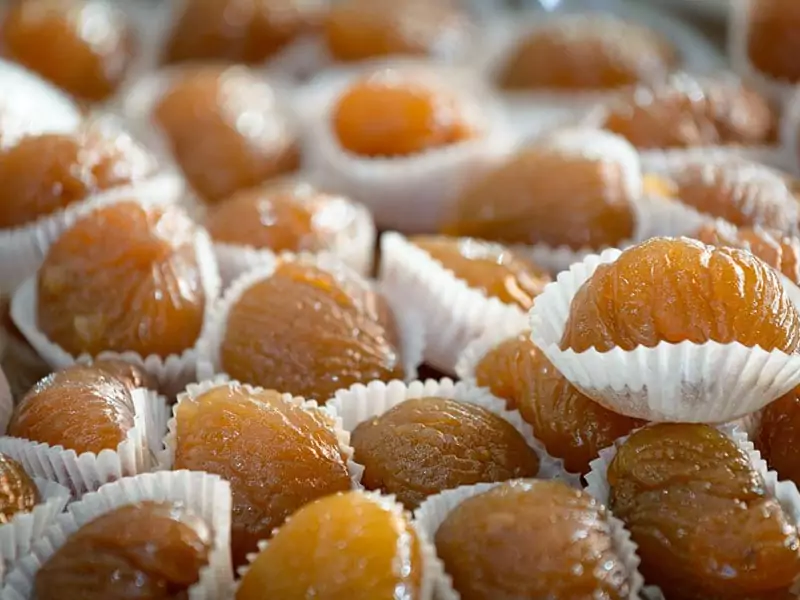
I often find myself unable to resist the richness of Marrons Glacé, French glazed chestnuts. While many people think that this treat might have come from Italy, I always think it is absolutely French. When fall or Christmas rolls around, I often go to markets, fairs, and festivals to find it.
Its preparation involves boiling and peeling the chestnuts, then bathing them in a syrup made from sugar, honey, and spices. The result is a sweet and buttery street food that warms my soul to the core. It may be expensive, but worth every cent.
Éclair / Eclairs

Éclair is a classic French pastry that can work as a snack or light lunch. It is also often referred to as a French sweet treat. It is made with a flaky choux pastry shell that encloses fillings of creamy crème pâtissière (pastry cream), rich chocolate, or coffee cream.
One variant I particularly love is the Paris-Brest, a ring-shaped spin on the traditional oblong éclair. This one is brimming with nutty hazelnut praline buttercream.
Pommes Frites (French Fries)
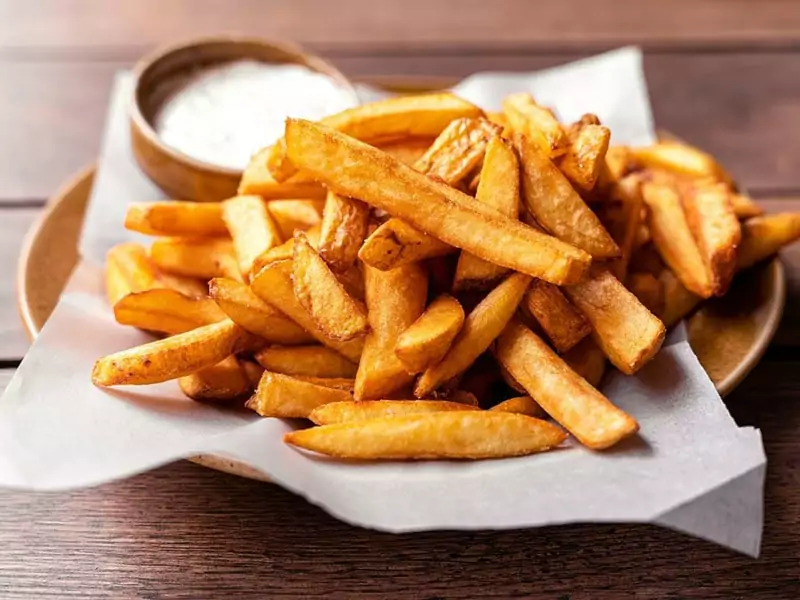
I’d like to introduce authentic French fries. While they are served in fast-food restaurants around the world, there is something intriguing about enjoying them in the country that gave them the name.
Pommes Frites are made from potatoes cut into lengthwise strips and deep-fried. They can be a side or a snack and go with many accompaniments, like ketchup (a classic crowd-pleaser), mayonnaise, garlic sauce, or cheese.
In Germany
Currywurst (Sausages With Curry Sauce)
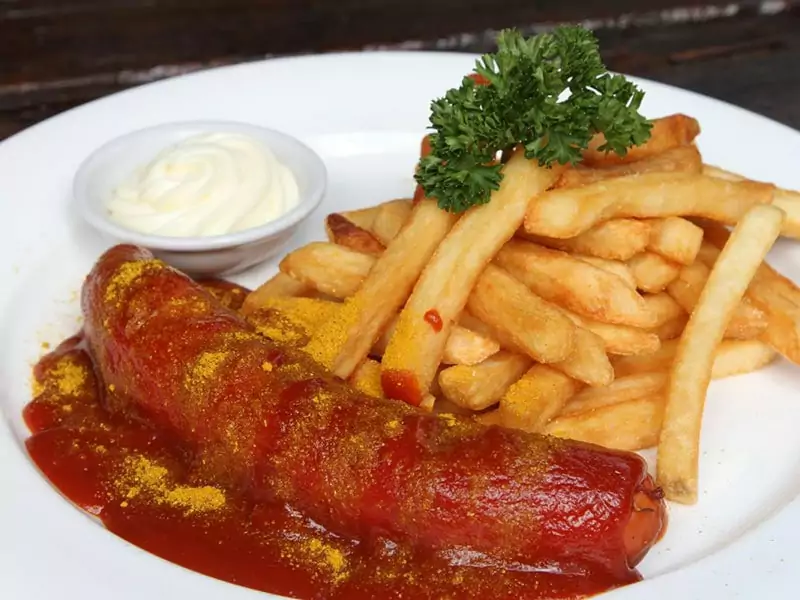
One of the most well-known German street foods is currywurst. Its main ingredient is a hearty sausage, preferably a German bratwurst, that is boiled or steamed before being fried and served whole or sliced.
An equally important part is the sauce, skillfully made from puréed tomatoes and curry powder. It adds a warm, spicy touch. The last step is a sprinkling of yellow curry powder to make the dish sing.
However, currywurst isn’t not complete without side dishes like French fries, onions, or a kaiser roll. While numerous German restaurants offer this dish, it’s my personal experience that Imbiss (snack shops) and gas stations are the best places to try it.
Bratwurst (Grilled German Sausages)

Bratwurst has a long history, tracing its roots back to 1313 in the city of Nuremberg. Traditionally, it’s a mix of pork (especially pork loin) and veal, seasoned with spices like coriander, ginger, and nutmeg. This vibrant German sausage type is boiled, then pan-fried or grilled to perfection.
There are over 40 different types of bratwurst, each with unique tastes. In a typical serving, locals put it into a white bread roll and drizzle with ketchup and mustard. That way reminds me of an American hotdog, but with a German twist.
Pretzels / Bretzels

In the early Middle Ages, European monks came up with pretzels, the now-famous German snack delight. Each has the shape of a twisted knot and is encased in a glossy glaze, the result of a special pretzel solution before baking.
The taste is a lovely mix of simple dough and seasoned salt. Accompaniments range from cheese and bratwurst to mustard, and beer. They all bring out the lively atmosphere of the old-world European streets.
Schnitzel (Breaded Cutlet)
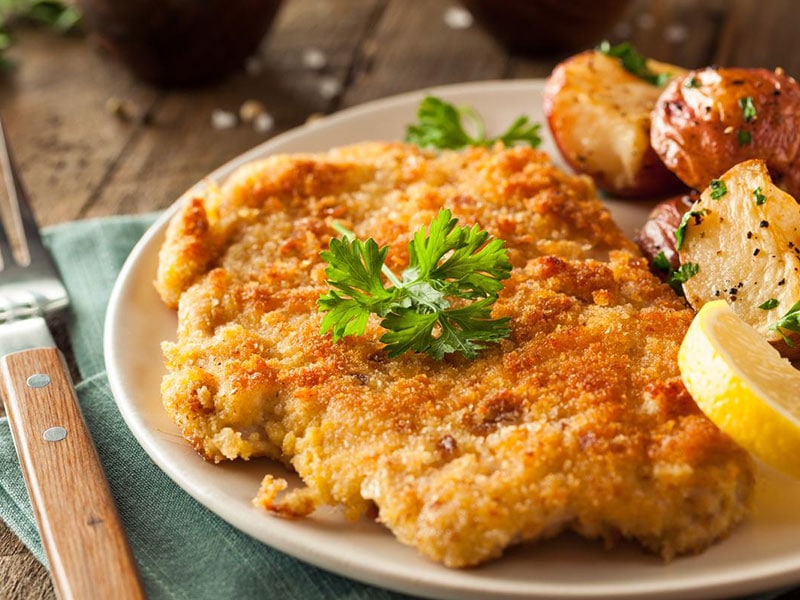
Schnitzel has strong ties to Austria, but you’ll see its influence all over Germany’s culinary tradition, particularly in the form of the similar dish Wiener Schnitzel. It’s hard to resist these thinly sliced veal, especially when they are coated in flour, egg, and bread crumbs, then deep-fried until golden.
There are several regional variants, each with its own special sauces. Zigeunerschnitzel requires bell pepper and Rahmschnitzel creamy sauce. A mushroom sauce is necessary for Jägerschnitzel, while Wiener Schnitzel demands ebbelwoi (apple wine sauce).
However, almost all Schnitzel dishes pair well with Pommes Frites, German vegetables, or German potato salad.
In Netherland
Stroopwafel (Syrup Waffles)

This Dutch version of waffle is quite a treat, with a thin syrup layer made of sugar, butter, and cinnamon sandwiched between two delicate wafers. It harkens back to the late 18th century, invented in the city of Gouda. A baker named Gerard Kamphuisen, is often credited for this creation [2].
A traditional way of eating them is with tea or coffee – simply place one atop your cup and let the steam work its magic on the syrup layer. While you can find these in supermarkets, cafes, or open-air markets, a freshly prepared Stroopwafel from a food stand is unbeatable in my book.
33. Bitterballen (Dutch Meatballs)
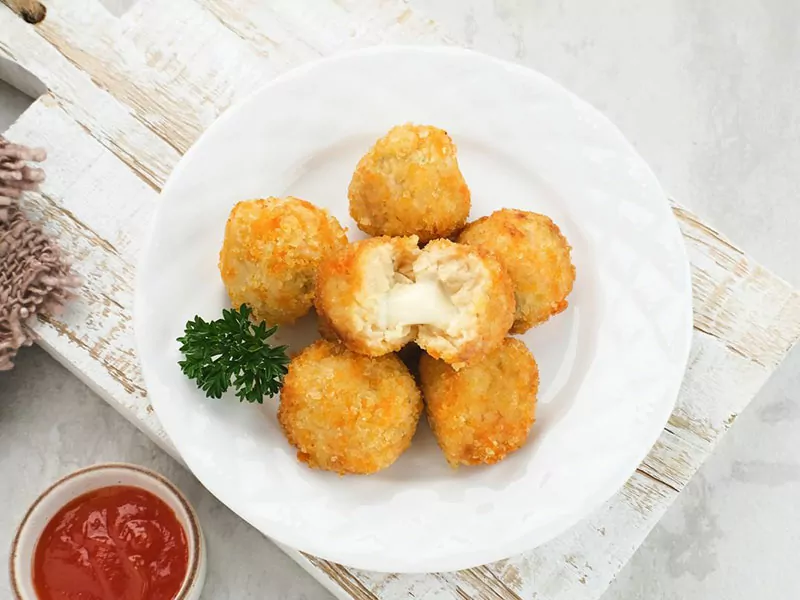
Meatballs are a savory snack in many countries, and the Netherlands is no exception. Its bite-sized Bitterballen is a mix of minced beef, beef broth, butter, flour, herbs, and spices. It is coated in batter and breadcrumbs before being deep-fried to a golden brown.
Bitterballen is a popular bar snack. There is nothing like pairing Bitterballen with a smear of mustard and a cold beer.
34. Poffertjes (Mini Pancakes)
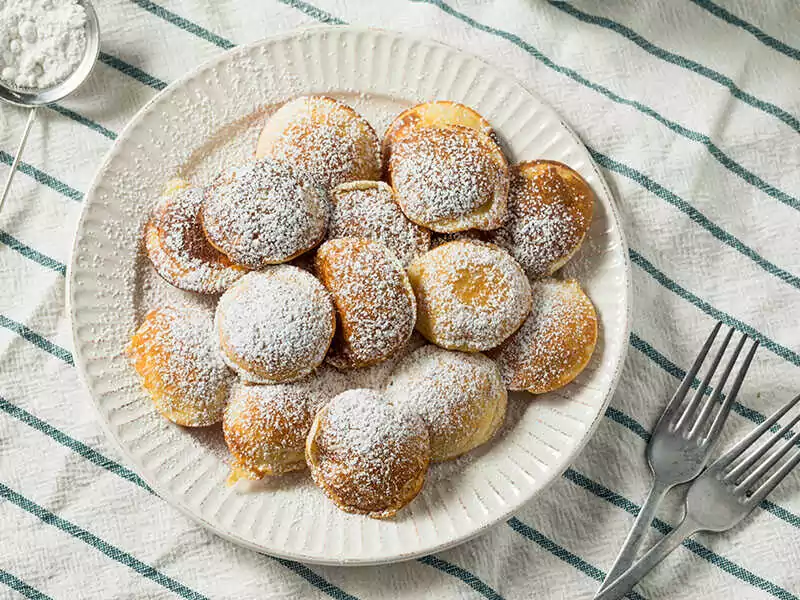
These small, round and puffy Dutch pancakes are far from your typical breakfast food. Instead, they make a popular snack, especially during Christmas and New Year celebrations. Interestingly, this tasty morsel was once viewed as a poor man’s dish until the 19th century began.
Their distinct taste comes from a unique blend of yeast and buckwheat flour, which is baked in a special cast iron or copper pan known as a poffertjespan. Once cooked, these bite-sized delights are served warm on cardboard paper, particularly at outdoor events.
Topping choices have evolved over time. While traditionalists might stick to melted butter and powdered sugar, modern enthusiasts top them with everything from whipped cream and fresh fruit to chocolate and even rum.
35. Oliebollen / Oliebol (Dutch Doughnuts)
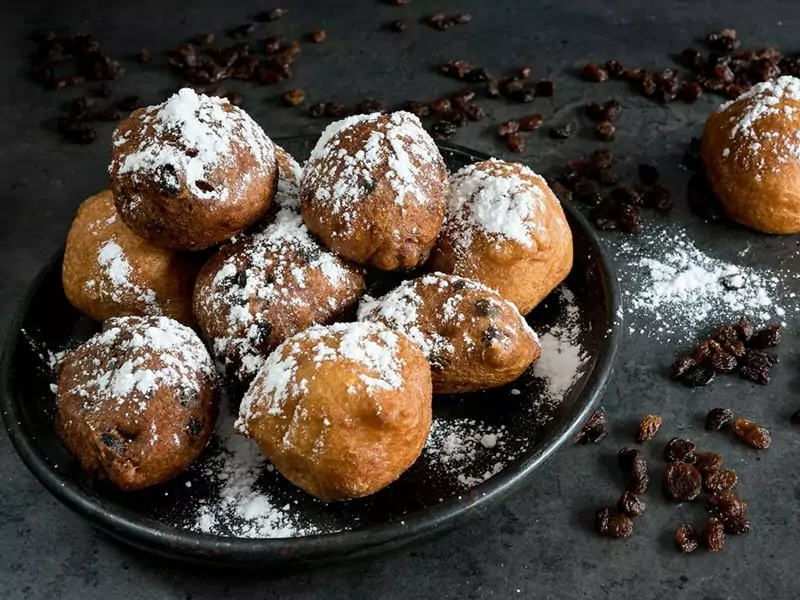
Oliebollen, literally “oil balls”, are a personal favorite of mine. You can see stalls selling this deep-fried treat at funfairs in winter and on New Year’s Eve.
The dough is made from ingredients like flour, eggs, yeast, milk, baking powder, cinnamon, and salt. Sometimes, raisins are mixed into the dough for added sweetness. Once out of the fryer, they’re dusted with powdered sugar and served with additional raisins and currants.
36. Kibbeling (Dutch Fried Fish)
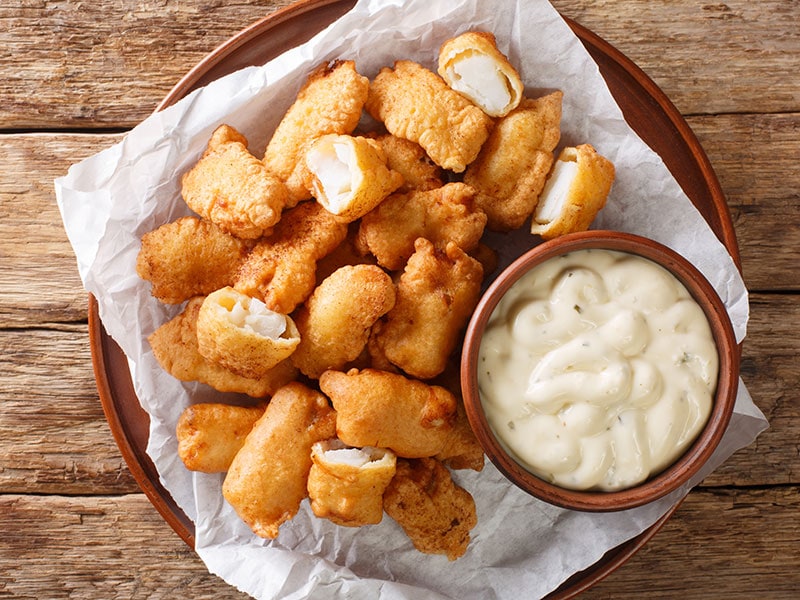
Kibbeling is a popular street food in Amsterdam, where many food trucks and restaurants dish out this delicacy. It is like chicken nuggets yet made with made cod or cod’s cheeks instead of chicken. The golden nuggets are usually served with French fries and a fresh salad.
To ramp up the flavor, dipping sauces such as garlic sauce, mayonnaise, remoulade, ravigote, or whiskey sauce are offered. Though usually served as a snack, Kibbeling can double as a dinner.
37. Poffert (Dutch Raisin Cake)
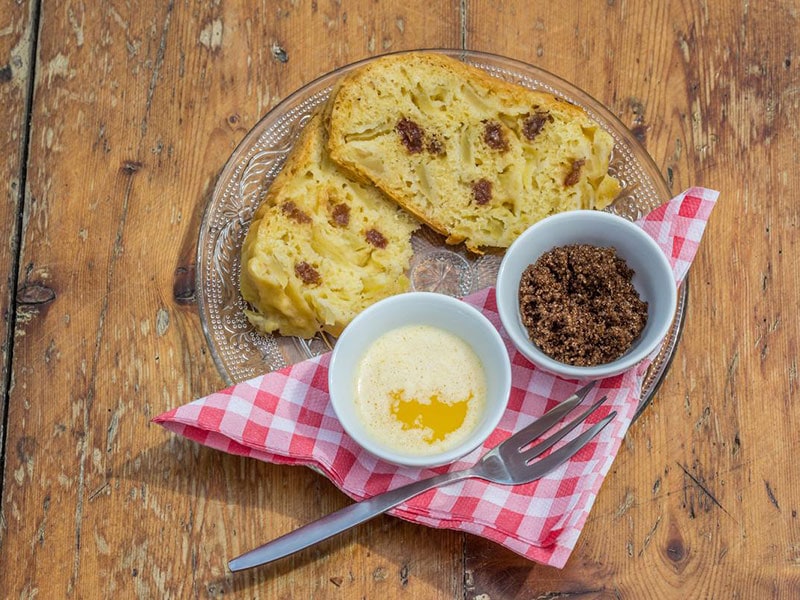
This fascinating Dutch delicacy hails from Groningen. It is made with a blend of wheat flour, buckwheat flour, yeast, milk, eggs, and a handful of dried fruits, often raisins or currants.
The dough is then poured into a specialized pudding mold and cooked in a water bath. Locals often savor it while sipping some tea or coffee.
In Belgium
38. Belgian Waffles

You may know that these waffles are ideal Belgian desserts or breakfasts, or that they are prepared in a specially designed waffle iron. But are you aware that they come in two distinct types? First, there’s the Brussels waffle, characterized by a light and thin batter.
Contrastingly, the Liege waffle presents a denser texture with its thick, brioche-like dough, complete with rounded edges and small clumps of sugar embedded within. Regardless of the variety, both can be generously topped with whipped cream, ice cream, Nutella, nuts, or strawberries.
39. Belgian Fries
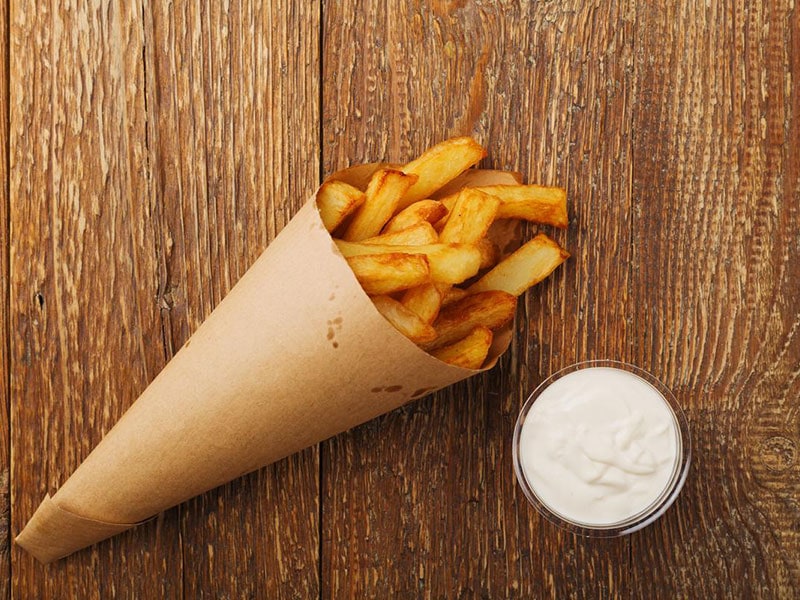
People around the world say French fries, but Belgians always call the dish Belgian fries, and for a good reason! Belgium may actually be the birthplace of, ahem, French fries. Locals always double-fry their fries for the best flavor and crispness.
While Belgian fries are good enough on their own, they pair wonderfully with a range of dishes. From Bitterballen, the savory Dutch meatballs, to burgers, cheese croquettes, and chicken fingers, the possibilities are endless. Any dipping sauce can joy the party, too.
In Sweden
40. Tunnbrödsrulle (Swedish Hot Dog)
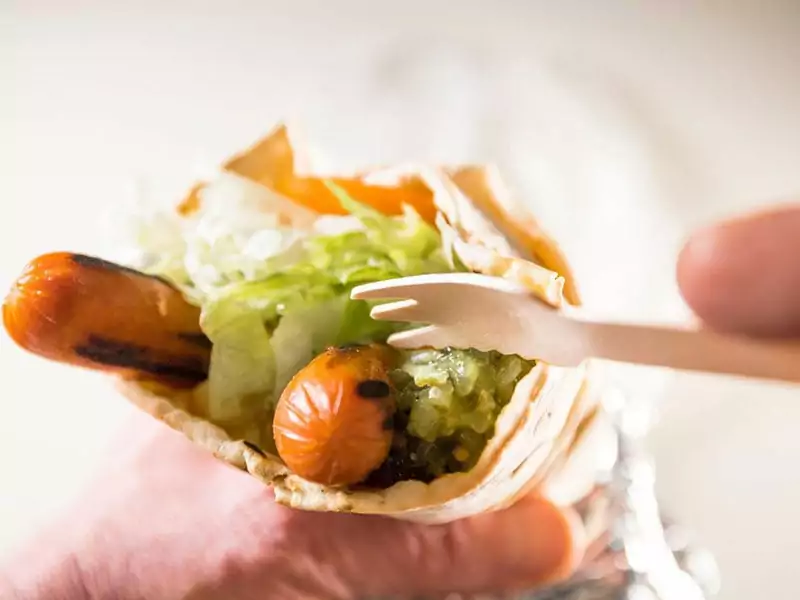
Tunnbrödsrulle is a delectable hot dog variety that comprises flatbread wrap with grilled or boiled sausages. Inside this comforting parcel, you’ll find mashed potatoes, shrimp salad, raw and fried onions, and lettuce, with a drizzle of ketchup, mayonnaise, or mustard.
This is a late-night go-to for many of my Swedish friends. A word of advice they give me is to visit korvkiosks, hot dog-specializing street stands in Sweden, for the best experience.
41. Semla / Fastlagsbulle (Fat Tuesday Buns / Lenten Buns)

Semla, or Fastlagsbulle as called in southern Sweden, is a warm, cardamom-spiced wheat bun. The top part is cut off, and the bun is hollowed to make room for a delicious filling of milk and almond paste. Then, the cook crowns it with a generous helping of whipped cream.
The last step is to close the bun with the cut-off top, and dust it with powdered sugar. Its decadence can be savored alone, or accompanied by coffee and tea. Immersing Semla in a bowl of hot milk is another great idea. It is a common sight at Lent and Shrove Tuesday.
In Finland
41. Karjalanpiirakka (Karelian Pie)

In Finland, Karjalanpiirakka is equivalent to Italian pizza. Hailing from the Karelia region, this rice pie begins as a humble local snack. Now, it has been embraced as a Finnish favored food, even in Estonia and parts of northern Russia.
Its crust, made from rye flour, contains a rich filling of rice (or barley porridge) and, sometimes, mashed potato. The pie is covered with the egg butter called Munavoi.
Whether at breakfast or snack time, this traditional delight can be found at street stalls, bakeries, cafes, and supermarkets. It is also a traditional wedding dish.
42. Kuuma Koira (Finnish Hot Dog)
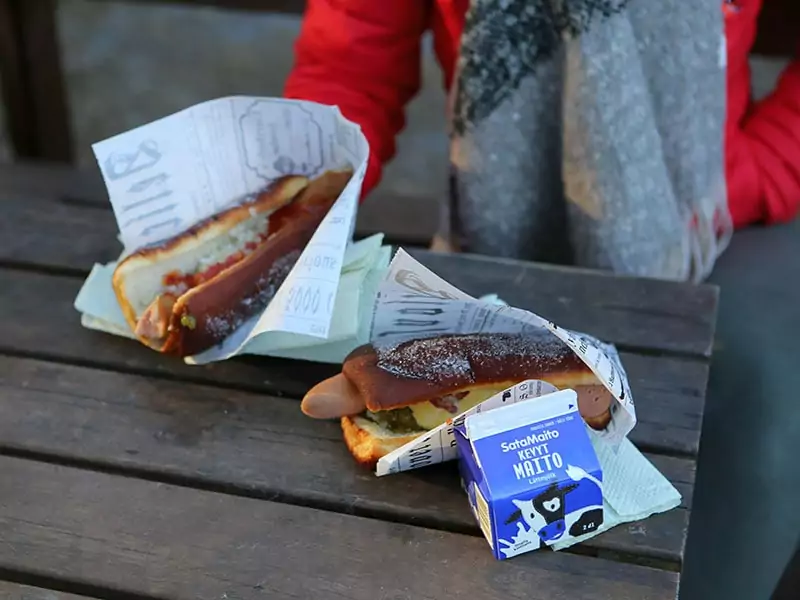
The Finnish town of Nokia is famous for many things, including the giant Nokia Corporation and the famous Finnish hot dog Kuuma Koira. The latter was created in the 1960s by a fast food grill owner named Teodor Leppänen.
Kuuma Koira started with apple jelly doughnuts before switching to the current version: sugar-dusted doughnuts with sausages tucked in. It also consists of ketchup or mustard, pickle relish, and chopped raw onions.
Unlike American hot dogs, Kuuma Koira, wrapped in grease paper, often goes hand in hand with a glass of milk. Roadside stands and fast-food kiosks are its usual hangouts.
43. Lörtsy (Finish Deep-fried Pastry)
A trip to a Finnish restaurant introduced me to Lörtsy, a large, crescent-shaped pastry from the Savonia region in the east of Finland. It is deep-fried and filled with either sweet or savory fillings, such as minced meat or apple jam.
A sugar-coated Lörtsy is perfect for dessert, while a savory one can make a good snack with a side of pickled cucumber, chopped raw onion, and maybe a hot dog sausage. People usually fold it like a taco.
In Russia
44. Chebureki (Deep-Fried Dumplings)
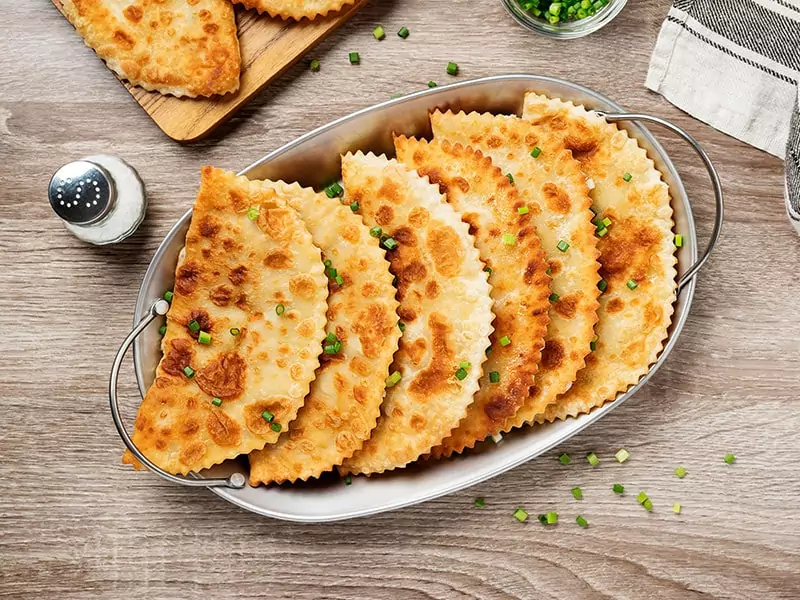
When wandering through Moscow, I often get a quick energy boost from Chebureki, a treat of Crimean origin, and the Tatar version of Burek. Shaped like a crescent, the deep-fried turnover is made of pastry dough and filled with minced meat, onions, beef, lamb, mushrooms, or cheese.
This hearty Russian dish is nutritious enough to be a fantastic on-the-go snack or lunch. Each Chebureki is swiftly fried in boiling oil, creating a crisp exterior that wraps around its savory filling.
You can try it at a cheburechnaya, a simple self-service cafe dedicated to pastry, a cultural icon linking back to the Soviet era.
45. Kukuruza (Serbian Corn)
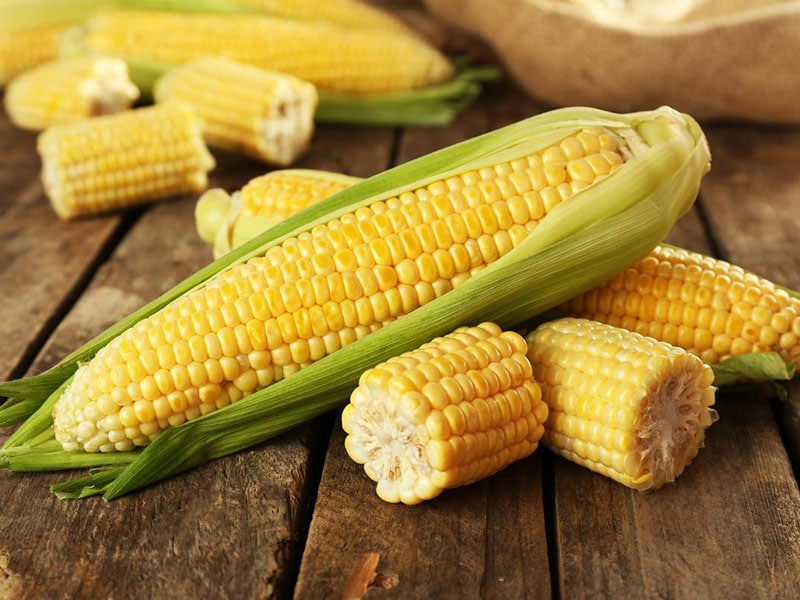
The name Kukuruza can refer to a special Balkan cornbread, but in Russia, it is essentially buttered ears of corn. It is a simple yet enticing treat that should be enjoyed hot straight out of the grill.
46. Shashlik (Russian Kebab)
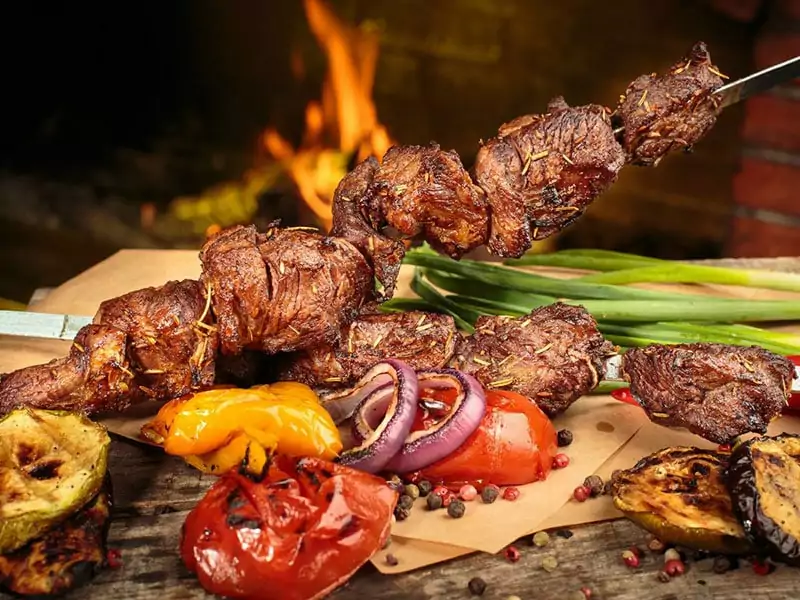
Shashlik is a familiar fast food in the vibrant Russian street food scene. Like kebabs, it includes skewered cubes of meat that are grilled until juicy. The meat must be first marinated in a mixture of vinegar or dry wine, onions, herbs, spices, and perhaps sour fruit juice.
The choice of meat was initially lamb, but beef, pork, or venison are favorites now. Sometimes the skewers are purely meat, other times intertwined with fat and vegetables, such as tomatoes, onions, bell peppers, and mushrooms.
47. Blini (Russian Pancakes)
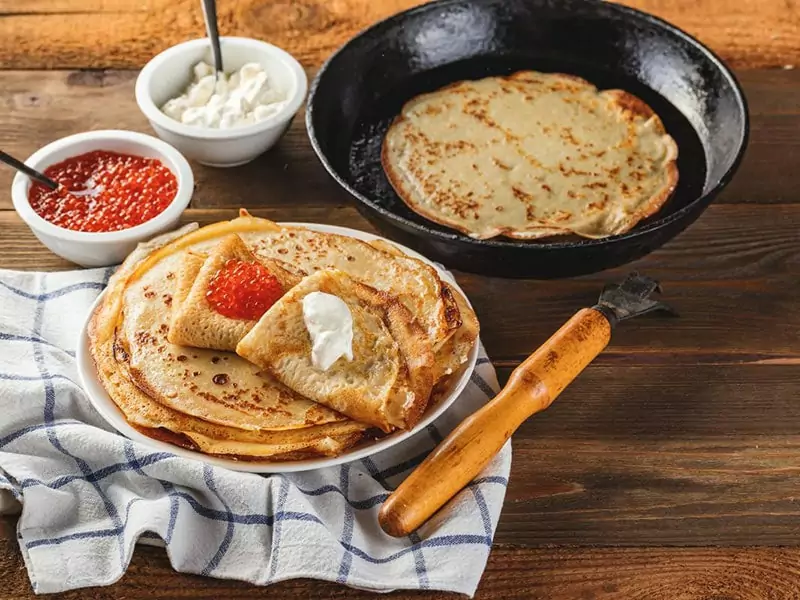
This Russian pancake is made of buckwheat or wheat flour and cooked on a girdle. Its additional ingredients are diverse: savory fillings include ham, cheese or caviar, and while honey, jam, or condensed milk is important to a sweet Blini.
As for accompaniments, smetana (sour cream) or tvorog (fresh cheese) gives it a creamy touch. Alternatively, a bowl of Borscht or Shchi soup adds a lot of warmth. Blini is available in many places, but the Russian fast food chain Teremok is my favorite destination.
48. Pirozhki (Hand Pies)
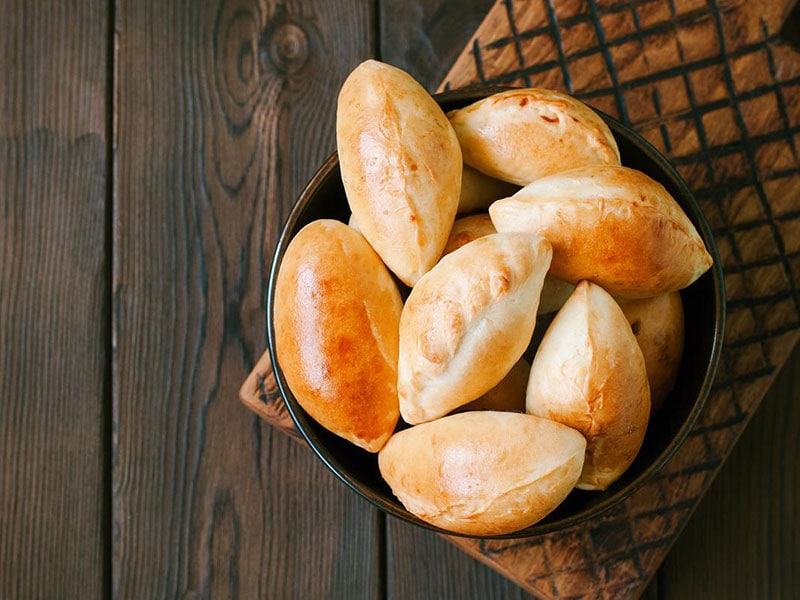
Pirozhki (“little pies”) are yeast dough buns filled with an assortment of sweet or savory fillings. They can be stuffed with berries, fruits, or cottage cheese for a Russian-style sweet treat. If you’re into a savory snack, there are versions packed with ground meat, eggs, or vegetables.
Be it oven-baked or pan-fried, Pirozhki is unfailingly a perfect bite-sized appetizer or snack. It is available in many sizes, but I often see small variants in cafeterias.
In Ukraine
49. Perepichka (Ukrainian Hot Dog)
Hailing from the Ukrainian capital, Perepichka is a unique take on the classic hot dog. It’s a simple, yet mouth-watering combination of a sausage enveloped in a blanket of fried dough. Grabbing a Perepichka from a bustling street vendor on a chilly day is a joy like no other.
50. Sirniki (Cheese Pancakes)

Sirniki is a warm embrace in the form of a mini pancake on chilly mornings. I’ve started many of my days with these cottage cheese-filled pastries, accented with sour cream, sugar, jam, or honey. With a cup of coffee, it’s the epitome of a perfect morning for me.
But this dish is also a wonderful dessert in Ukraine. No wonder why it also holds a beloved spot in Russia and Belarus.
51. Bublik (Ukrainian Bagels)
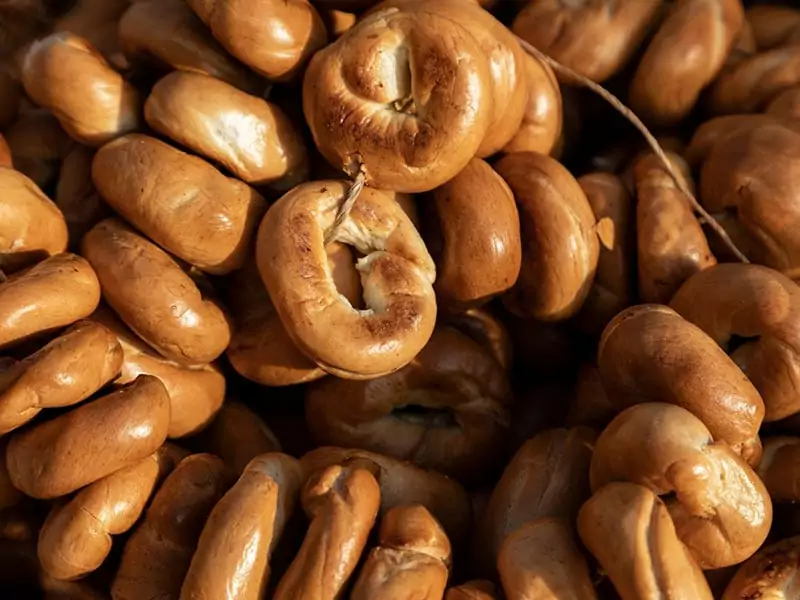
This traditional bread roll’s roots trace back to the Jewish population in czarist Russia, but it found its present form in Ukraine. Therefore, while you can find the round, yeasted bun in many Eastern European countries, Ukraine is still my go-to place to try it.
Bublik has a likeness to a bagel, yet its form is larger, denser, and chewier. People often briefly poach this traditional Ukrainian delicacy in water and give it a quick dusting of poppy seeds, sesame, or sugar to ready it for the oven. Like many other sweet snacks, it goes well with tea and coffee.
In Georgia
52. Khachapuri (Georgian Cheese Bread)
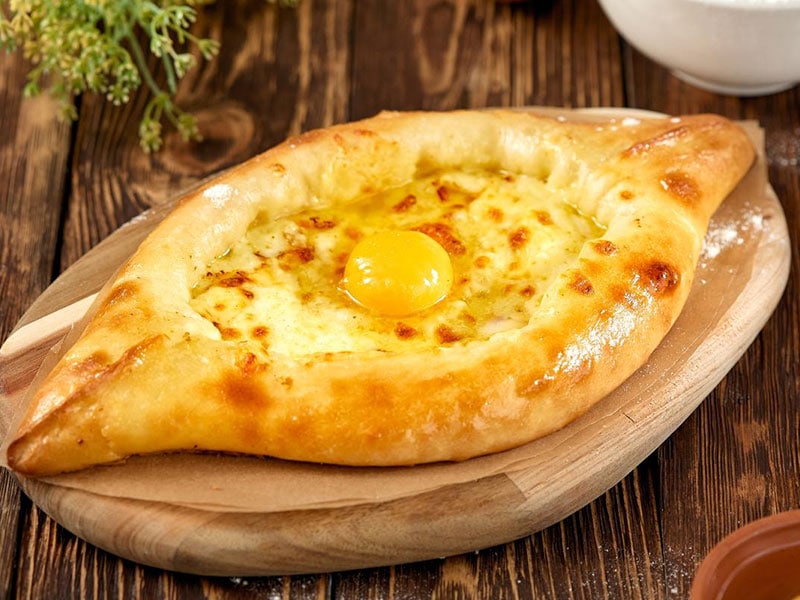
Khachapuri is a flawless symphony of melted cheese, eggs, and butter. The best choice of cheese is commonly the local Sulguni or Imeretian cheese, but modern adaptations now include mozzarella and feta.
The cheese bread comes in many varieties, but I have a fondness for two: the circular Imeretian version and the open-faced, boat-shaped Adjaran variant. The latter boasts a buttery egg-based topping.
Khinkali (Georgian Dumplings)
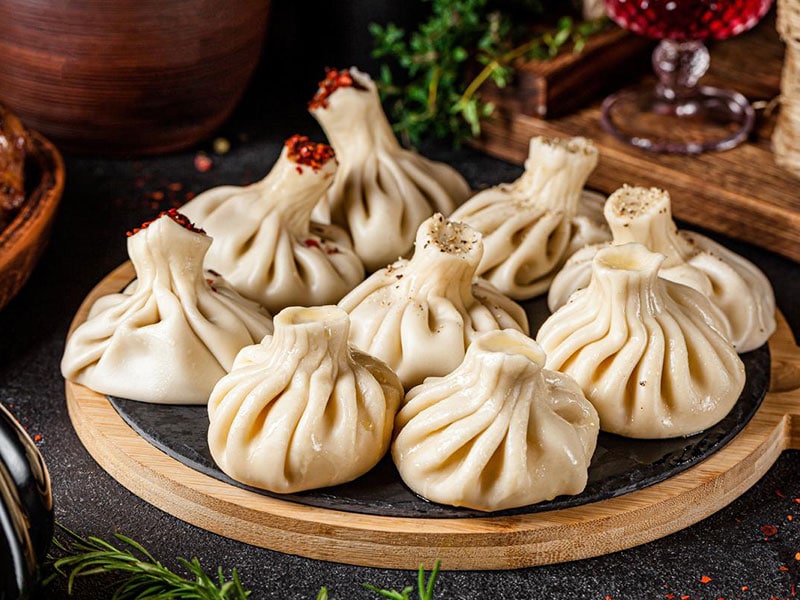
Khinkali is a culinary gem from the mountain regions of Pshavi, Mtiuleti, Tusheti, and Khevsureti. It is a beloved dish across Georgia, especially in the country’s capital city, Tbilisi, where many foodies claim to offer the best bite.
Resembling Shanghainese steamed buns Xiao Long Bao, Khinkali has a thicker, unleavened dough, which is made from wheat flour and crafted into knobby, twisted dumplings.
These dumplings are boiled, not steamed, and contain a mixture of spiced ground meat (like pork, beef, or lamb) and a savory broth. Some recipes replace meat with vegetables (like mashed potatoes), mushrooms, or cheese. Black pepper for seasoning is the perfect finishing touch.
In Turkey
Simit (Turkish Sesame Bread)
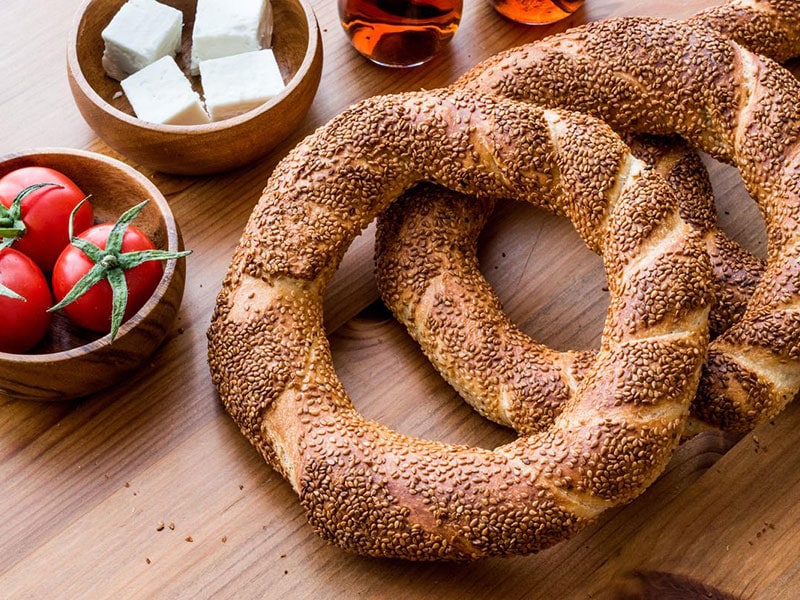
Simit, a symbolic staple of Turkey, stands out as a versatile snack or a crucial part of the Turkish breakfast. This ring-shaped bread, with a balance between a bagel and a pretzel, is made from basic ingredients: flour, yeast, water, and salt.
The dough, dipped in grape molasses and crowned with sesame seeds or poppy seeds, offers a distinct taste that you can savor plain or pair with Turkish tea. A range of spreads, from Turkish cheese and clotted cream to honey and hazelnut butter, can enhance its flavor.
Simit carts or vendors with trays piled high with this delicacy on their heads have become a charming sight around Istanbul. Besides being human food, any leftover Simit finds a second life as seagull feed.
Doner / Doner Kebab
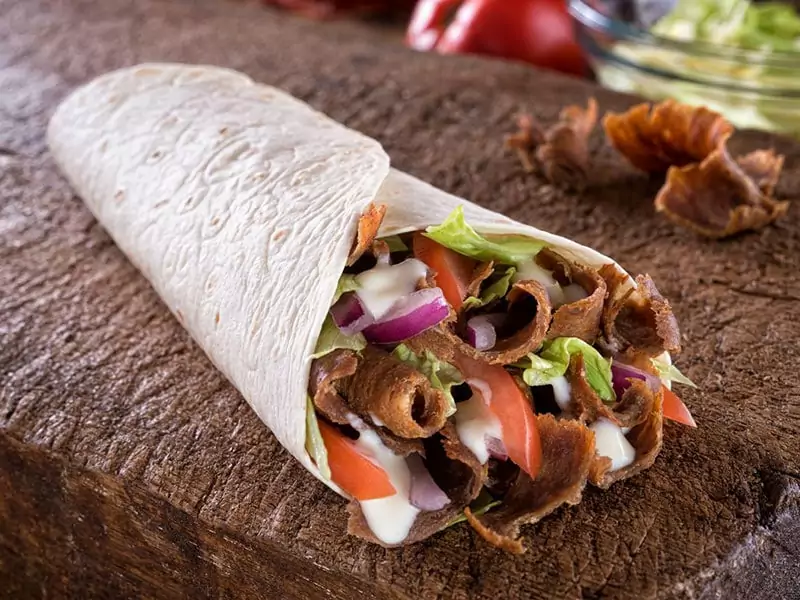
Doner Kebab is a special variety of Kebab. Locals cook it slowly on a vertical rotisserie, imbued with tail fat for hours. It parallels a Gyro, using lamb, beef, or chicken as meat options.
Once ready, it’s wrapped in a pita and sprinkled with a range of fresh salad or vegetables such as cabbage, chili, cucumbers, lettuce, onion, sumac, and tomatoes.
Served warm with fried potatoes, rice, sauces, and a yogurt drink, it’s a sought-after dish in Mediterranean, Levant, and North African cuisines.
Gozleme (Turkish Stuffed Flatbread)
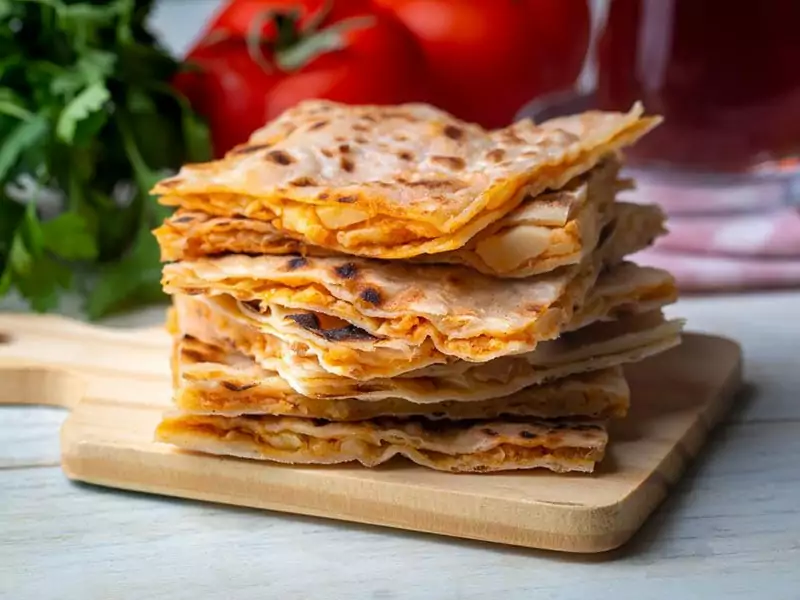
Gozleme is a savory pancake that embodies a fusion of simple, yet flavorful ingredients. The dough gets a unique texture from flour, yeast, olive oil, yogurt, salt, and water, then rolled with a small-diameter “Oklava” pin until thin.
Once rolled out, it comes with a variety of traditional fillings. This could be spiced cooked potato, mushrooms, a spinach/feta combo, eggs, cheese, or minced meat and onions.
Finally, locals will grill it on a gözleme saci – a hot metal grill. When served, you’ll see it accompanied by tomatoes and green chillies. Paired with Turkish beverages such as coffee or tea, it’s a popular quick bite from morning till afternoon at restaurants, food carts, and local cafés.
Plus, you’ll sometimes spot Gozleme at farmers’ markets, specialized Gozleme shops, and special events.
Lahmacun (Turkish Pizza)
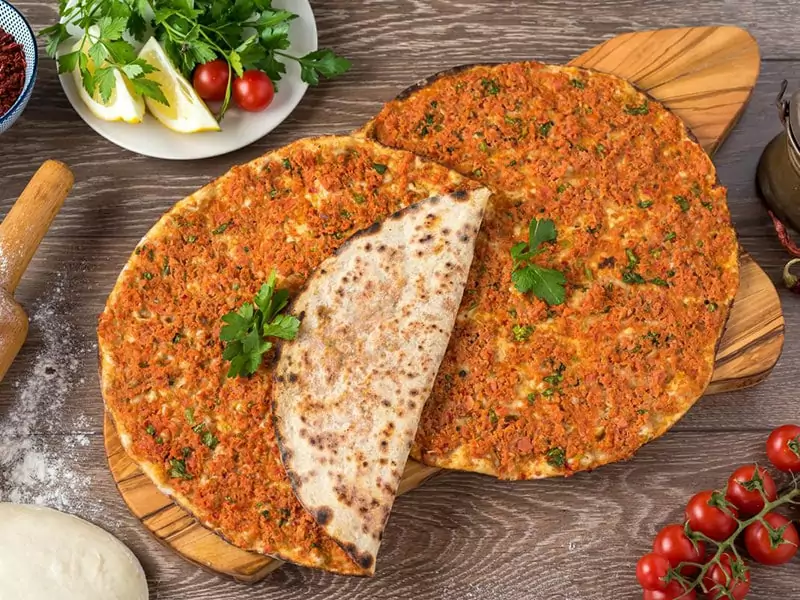
Here is a favorite street food and lunchtime snack at traditional Turkish restaurants called Lahmacun. It starts with a base of semolina dough, then lavished with a mix of spicy minced meat (lamb or beef), and vegetables like tomatoes, onions, and parsley.
The secret to the perfect Lahmacun is the careful seasoning of the meat with chili and onions, giving it a bold flavor. When it’s time to eat, just squeeze the lemon before rolling it into a wrap. For a well-rounded meal, I normally pair it with a cold Ayran, the Turkish yogurt drink.
In addition, you can also find some mini Lahmacuns in the local eateries. They are great to serve as appetizers.
In Greece
Souvlaki (Grilled Meat Skewers)
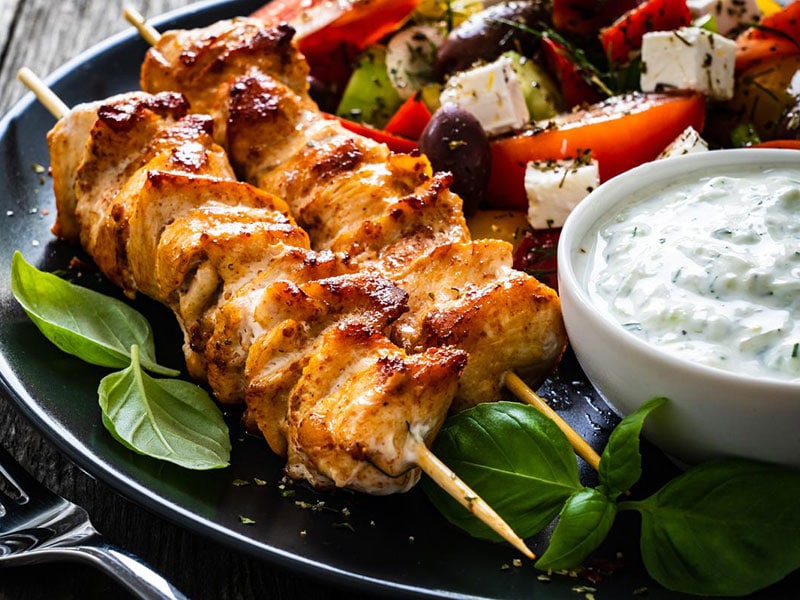
In the special Greek cuisine, you’ll find Souvlaki, a historical gem inspired by the shish-kebab. Its story began in ancient Greece, where grilled meat, pita bread, cheese, and dill came together.
The name ‘Souvlaki’ draws from the Greek word ‘souvla’, hinting at a spit, fitting for this dish of skewered and grilled meat, occasionally complemented by vegetables.
Today, whether it’s pork, chicken, lamb, or beef, the meat finds itself in good company with pita wraps, grilled bread, onions, tomatoes, or even French fries. This popular fast food has a cozy home in “souvladzidika”, small eateries that dish up Gyros and other grilled favorites.
Gyro
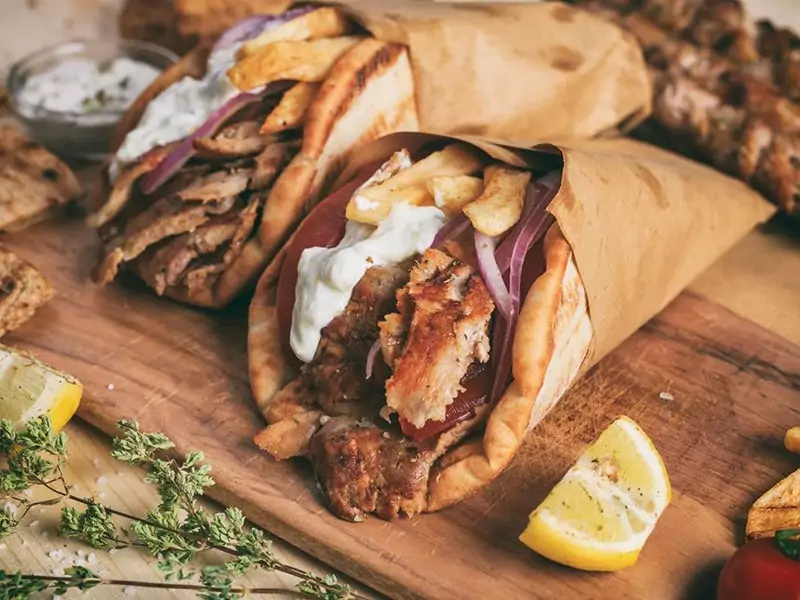
Gyro refers to a dish with its roots in the era of Alexander the Great. It gets the name from ‘gheereezo’, a Greek term for the rotating vertical spit on which it’s cooked.
Gyro was first popular in Athens, then rapidly gained popularity across the mainland, islands, and even made a big splash in the USA. Although frequently mistaken for Souvlaki, Gyro has its own unique charm.
My personal favorite is the Greek version with either pork, beef, or chicken, roasted beautifully on a vertical spit, then thinly sliced.
Each bite is a melody of flavors – nestled in a grilled pita, along with tzatziki sauce, Mediterranean veggies like tomatoes, red onions, lettuce, cucumbers, and an unexpected addition of French fries.
In North Macedonia
Pastrmajlija (Macedonian-Style Pizza)
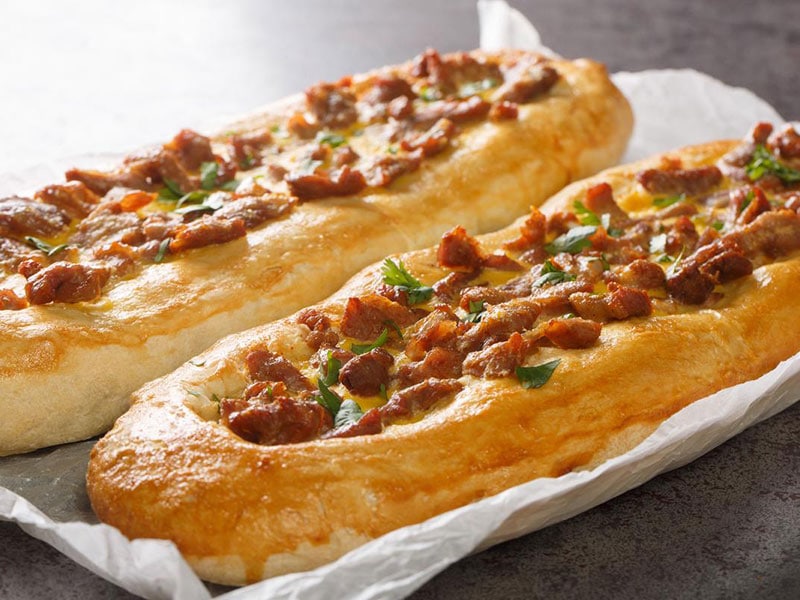
Pastrmajlija, with its name rooted in “pastrma,” refers to salted and dried sheep or lamb meat. In general, this is a Macedonian-style pizza that I’ve come to appreciate.
This pizza, inspired by the Turkish İçli Pide dish, features an oval-shaped bread pie generously topped with pork slices and eggs.
The pork, marinated with spices like paprika and cayenne pepper, truly enhances the overall taste. Then, it gets a garnish of chopped parsley and pepper flakes. It is an impressive main dish, ideally complemented by side dishes like salads, roasted bell peppers, or grilled veggies.
Simit Pogaca
From the bustling streets of Skopje, the capital city, you can come across Simit Pogaca, an exclusive breakfast staple and special dish of Macedonia. As a fusion of a bun and a sandwich, it includes a bun stuffed with burek, a pastry made from layers of phyllo dough.
Though there is no cheese or meat, the bun itself is sprinkled with a generous dose of sesame seeds. Its flavors and textures truly come alive when served hot or warm, making it a go-to morning delight exclusive to the city.
In Croatia
Fritule (Croatian Fritters)
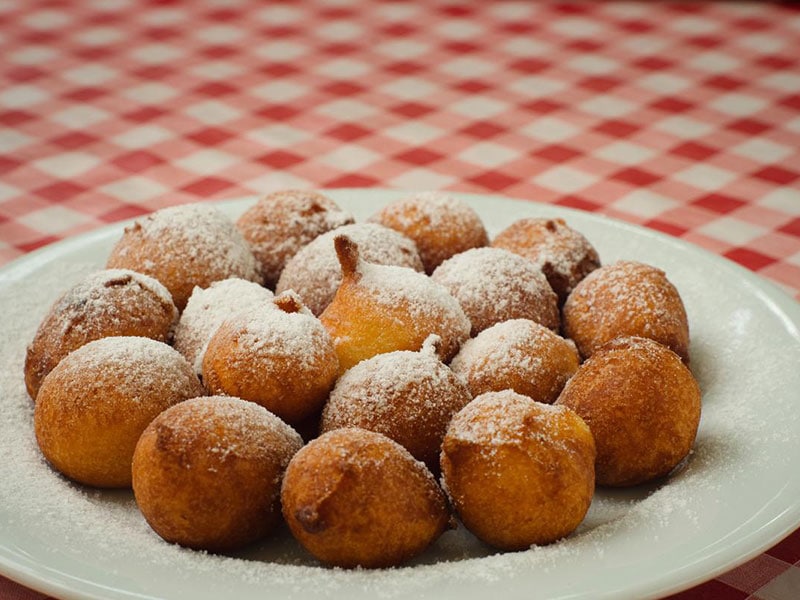
When I think of Fritule, my mind lights up with the sights and sounds of the Dalmatian coast. These little doughnuts are a symbol of Croatian culinary tradition, especially during the festive seasons of Christmas, Carnival, and Lent.
The yeast dough, whipped up with flour, butter, milk, egg, sugar, and yeast, gets a lively twist with Croatian rakija brandy or rum. Preparing them comes with its own ritual – letting the batter rise for around an hour before frying.
Once out of the hot oil, they’re dusted with confectioners’ sugar. A tip from my kitchen – to test if the oil is ready, I drop in a small piece of dough and wait for the sizzle.
Ćevapi
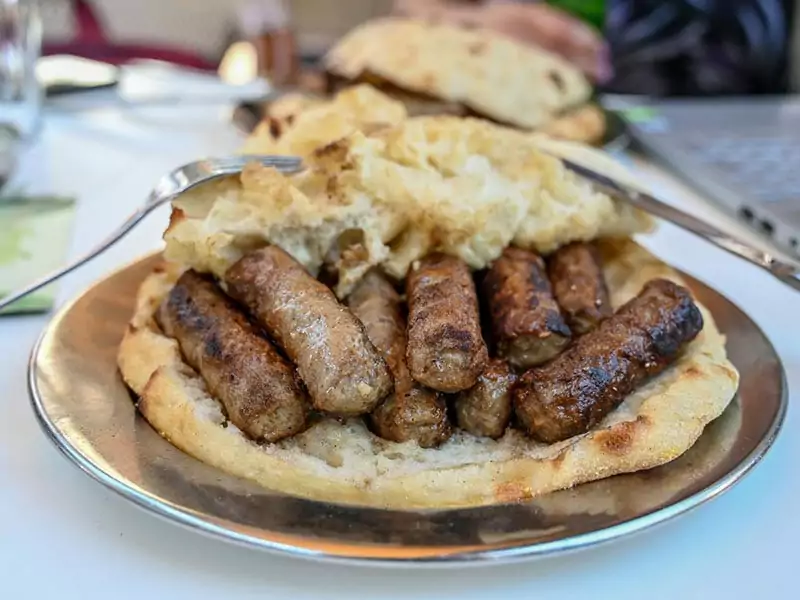
When I crave a hearty Balkan meal, Ćevapi often comes to mind. Not just a common dish in Croatia, it also holds a special place in Bosnia, Herzegovina, and Serbia, each with their unique recipes.
These grilled patties are a blend of minced meats like veal, lamb, beef, or pork. They carry the warmth of paprika, pepper, salt, and the renowned seasoning blend, Vegeta.
For serving, Ćevapi always comes between 5 to 10 pattiles or is snuggled in a flatbread with toppings such as onions or cheese.
In Hungary
65. Langos (Fried Flatbread)
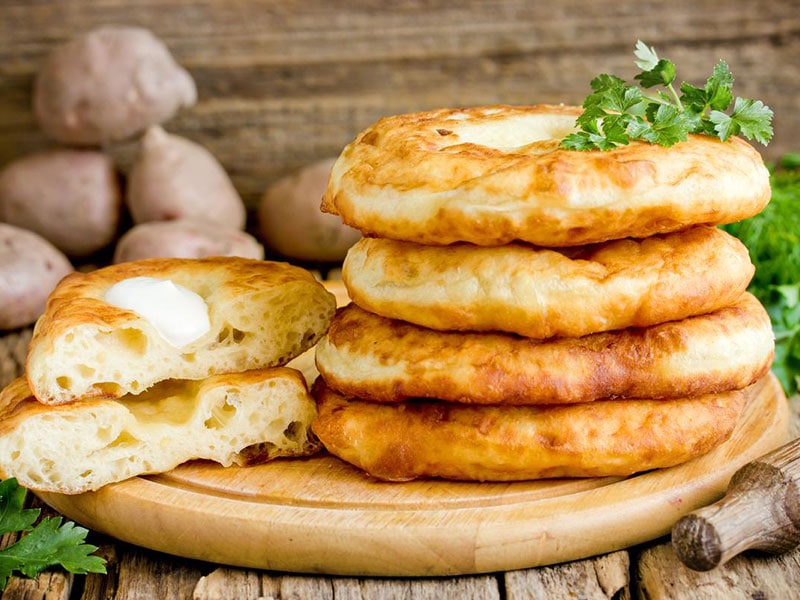
Originating from Hungary, Langos is a delightful fried bread, carrying the inviting aroma of warm dough and boasts a beautiful golden-brown color.
Crafted from simple ingredients like flour, yeast, milk, and salt, it also has a variant called Krumplis Lángos that includes mashed potatoes or others using sour cream.
Waking up to Langos is a joy – it’s often savored warm or hot for breakfast. Some prefer their Langos unadorned, but for others, the topping of grated cheese, garlic sauce, or sour cream is non-negotiable.
66. Kurtos Kalacs / Kürtőskalács (Hungarian Pastry)
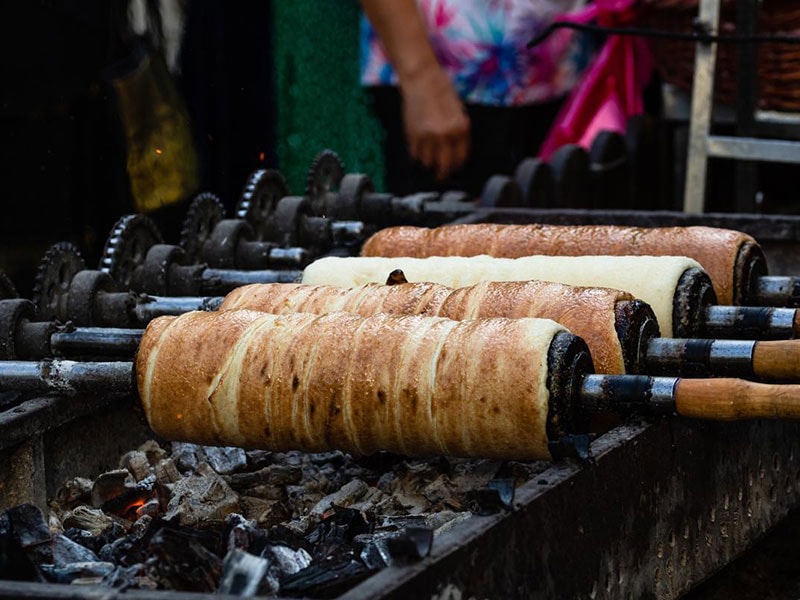
Kürtőskalács, pronounced “koortosh kahlahch,” is a traditional Hungarian dessert. The name literally translates as “chimney cake” because of its cylindrical shape, similar to a chimney’s structure.
The yeast dough is indeed rolled into long strips and wound around a wooden spit or dowel, hence the other nickname, “spit cake.”
It gets rolled in sugar before baked over an open fire. The heat caramelizes the sugar on the outside of the dough, creating a crispy, sweet crust.
You can find these gems as street food across the country, easily spotted in bustling Christmas markets in Budapest. They are also often found at festivals or other large public events.
67. Kolbice
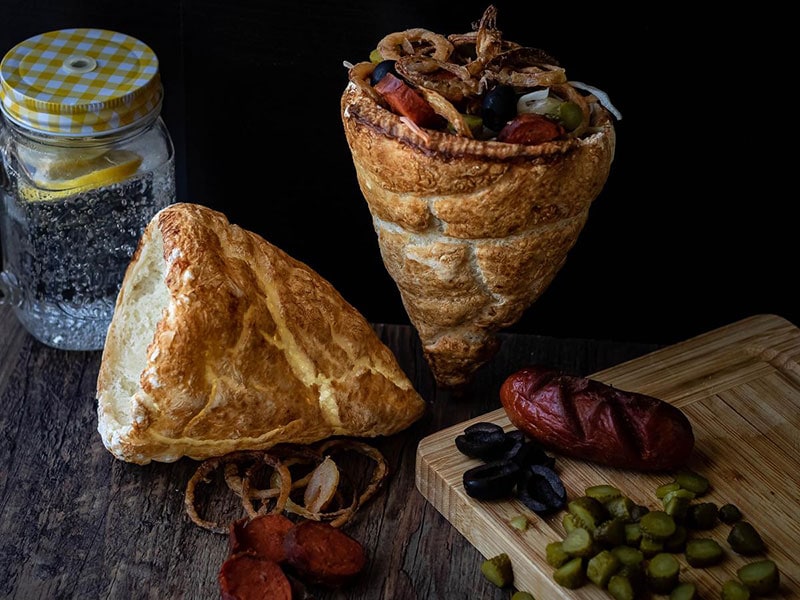
Kolbice is a Hungarian street food gem. A freshly baked cone made from seeded pastry is filled to the brim with sausages and your preferred sauces, mine being a decadent cheese sauce.
Once you’ve eaten the sausage with a handy wooden fork, the cone comes afterward. There’s an undeniable delight in having a custom-made Kolbice tailored to your taste, right from a food truck.
68. Goulash
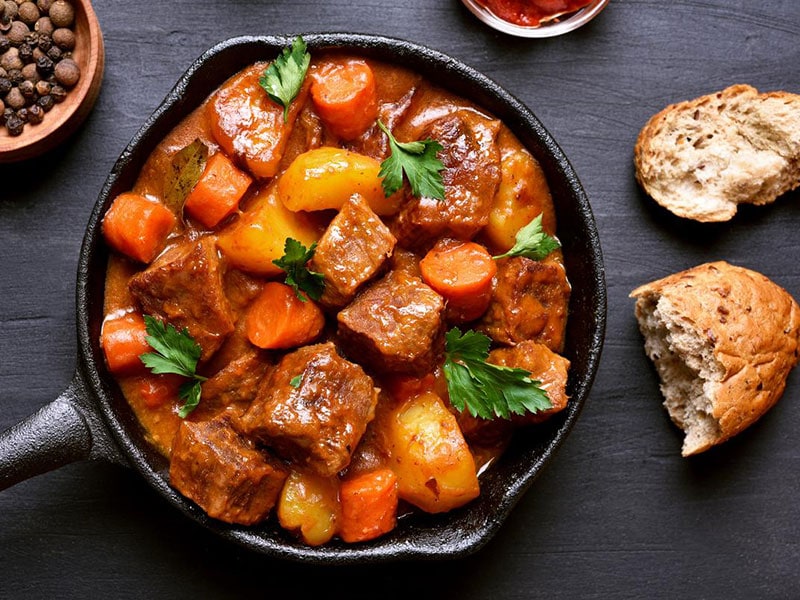
Goulash, or Gulyás, is the national dish of Hungary. Harking back to the 10th century, it is a stew brimming with meat, vegetables (typically potatoes), and aromatic spices. My personal preference leans towards the hearty chunks of shoulder or shank cuts of pork, beef, veal, or lamb.
For a luscious Hungarian dish, egg noodles can also complement the dish beautifully. But there are more versions of Goulash than the classic recipe, like the potato-less Székely Gulyás without potatoes, Csángó Gulyás with sauerkraut, or Mutton Gulyás for those mutton lovers.
Austria
69. Würstel

Würstel, that familiar name you’ve probably seen on a menu somewhere, actually means “Frankfurter” or “Vienna sausage” in German. Its popularity extends beyond Austria, with other European countries relishing it too.
Originating from Vienna in 1805, this dish is a combination of pork and beef stuffed into a casing of sheep’s intestine to form this sausage.
Parboiled and delicately smoked at low temperature, it’s normally served hot in a long bun with condiments. Its smoky taste is what I’ve appreciated over the years.
70. Tiroler Grostl
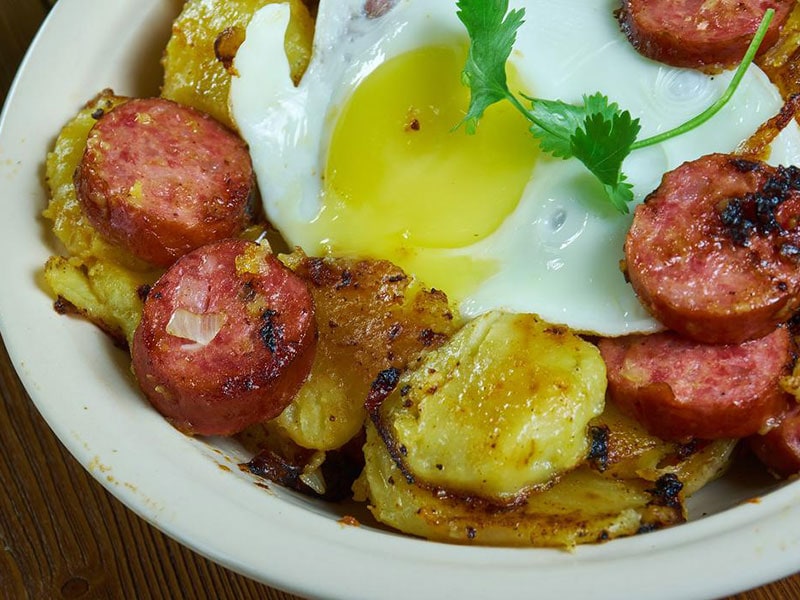
Tiroler Gröstl, or simply Gröstl, have been my favorite Austrian foods due to its heartening simplicity, yet full-bodied flavors. It’s a versatile one-pan dish, skillfully combining bacon, onion, potatoes, and beef with the spices mingled with these ingredients.
And the star that will catch your attention immediately is a sunny-side-up egg on top. I adore it not just for its taste, but also for its practicality. It’s a fantastic way to breathe new life into leftovers.
Czech Republic
71. Trdelnik
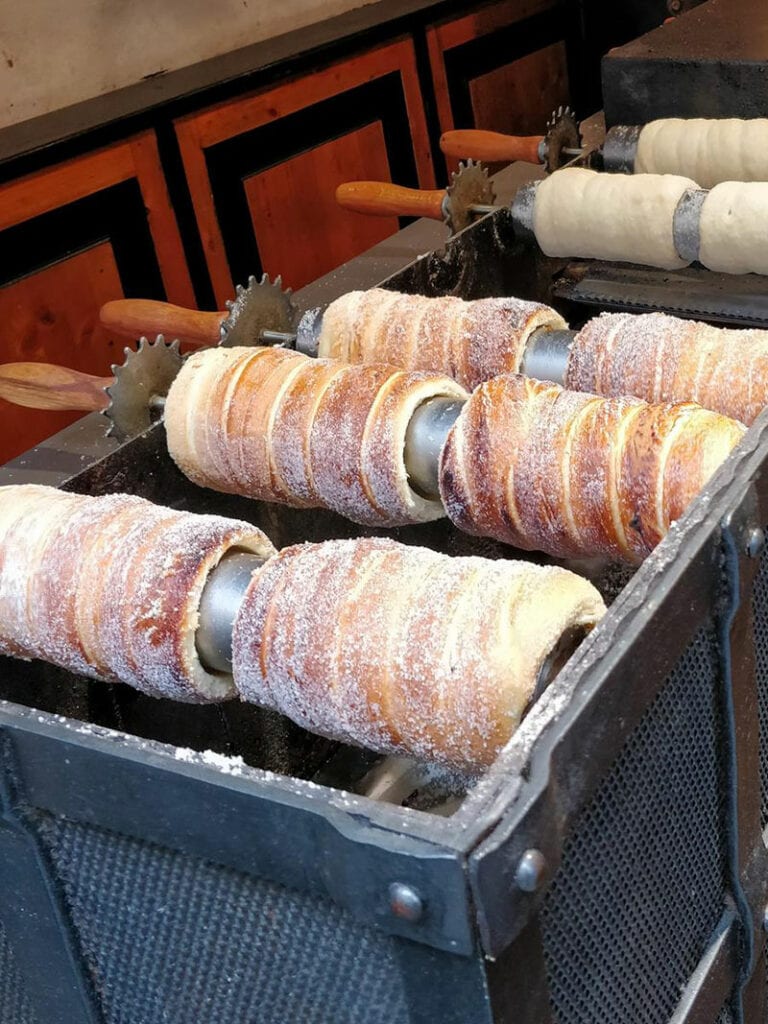
One of my all-time favorite treats is Trdelnik, an enchanting Czech cake. You might have heard it by other names – it’s called Kürtőskalács in Hungary and Baumstriezel in Germany.
These sweet swirls often appear at Prague fairs or markets. Made from similar ingredients to Kürtőskalács, but in a smaller form, Trdelnik is crafted from a light, bread-like dough, left hollow inside, then dusted with a blend of cinnamon and sugar.
72. Svíčková (Beef Sirloin In Vegetable Cream Sauce)
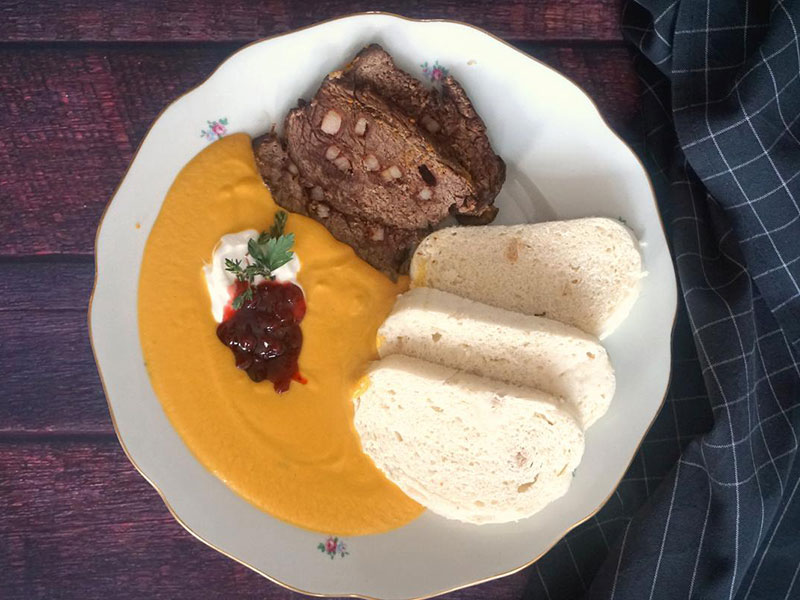
Another delicacy in Czech cuisine is Svíčková, or Svíčková Na Smetaně. This is one of the most sought-after Czech and Slovak meals. It includes sirloin steak, prepared with vegetables and seasoned with black pepper, allspice, bay leaf, and thyme.
The star element, though, is how it’s boiled with double cream, amplifying the richness. Then comes the finale, you can relish it with Houskové Knedlíky(Czech-style bread dumplings).
In Poland
73. Knysza
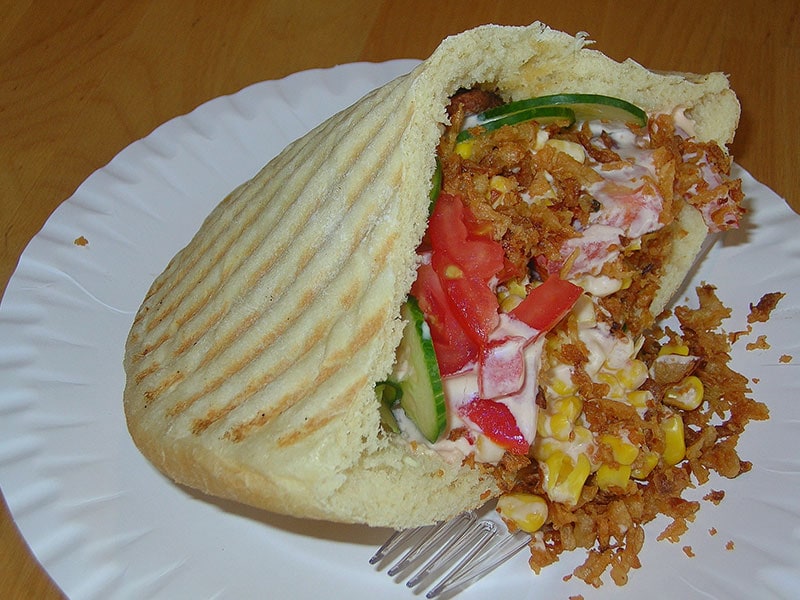
Knysza is a classic Polish street food that takes a humble bread roll on an exciting culinary ride. My first bite of this fast-food delight was in Wrocław, where it’s been a local favorite since the 1990s.
Picture a sliced-in-half sponge cake, sometimes grilled, and infilling with an exciting mix of ingredients. From fresh vegetables and juicy cutlets to a generous drizzle of delicious sauce, it’s a flavor explosion.
Whether you opt for the vegetarian, meat, or cheese version, it’s undeniably satisfying.
74. Pierogi
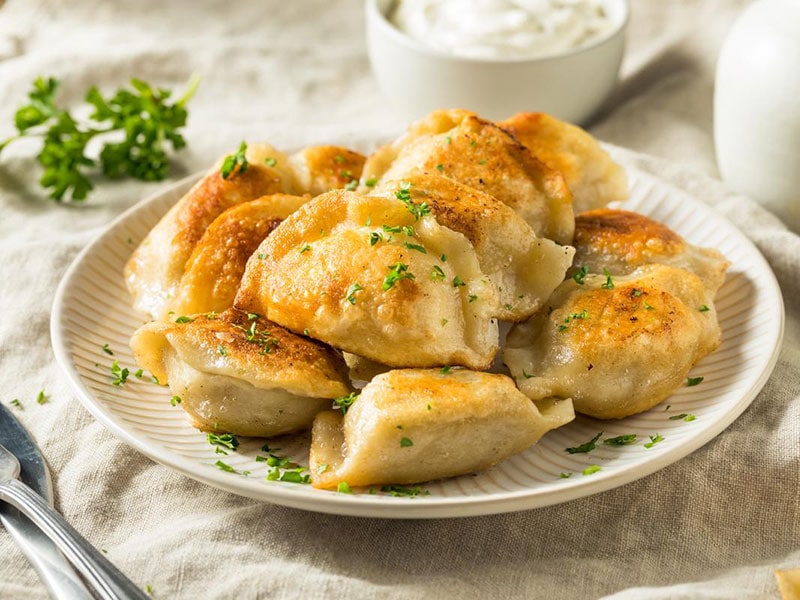
Pierogi are filled dumplings with savory or sweet fillings. They’re fondly named Varenyky in Ukraine. And they are also famous in Ukraine, Belarus, Russia, even America, and Canada.
Diverse cuisines of Central, Eastern, and Southeastern Europe find a piece of their culinary spirit in Pierogi. But overall, these bundles are wrapped in unleavened dough, then cooked in boiling water before gracing the plates.
Whether it’s meat, potato, cheese, sauerkraut, or even fruits that fill them, each Pierogi carries a tasty surprise within, sweet, savory, or spicy, as it pleases.
On festive occasions, these starlets sit proudly on tables, while doubling as street food or in specialized restaurants called “pierogerie.”
75. Zapiekanka (Polish Toasted Sandwich)
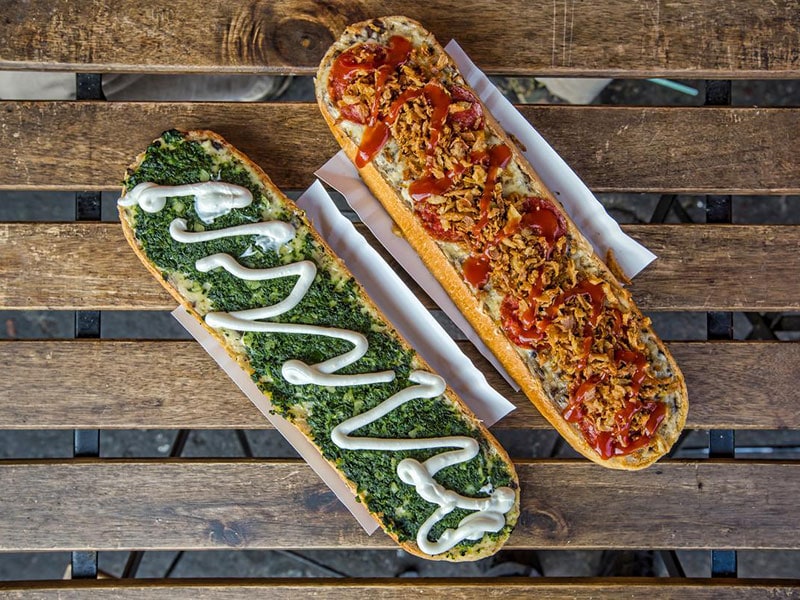
In the 1970s, a new sensation hit the Polish street food scene – the Zapiekanka. This toasted open-face sandwich starts with a sliced baguette or a long roll of bread. In this country, it is also known as Polish-style pizza.
Top that with sautéed white mushrooms and cheese, then add a few extras like ham if you fancy. But a generous drizzle of ketchup is what completes this classic snack.
76. Oscypek (Traditional Polish Highland Cheese)
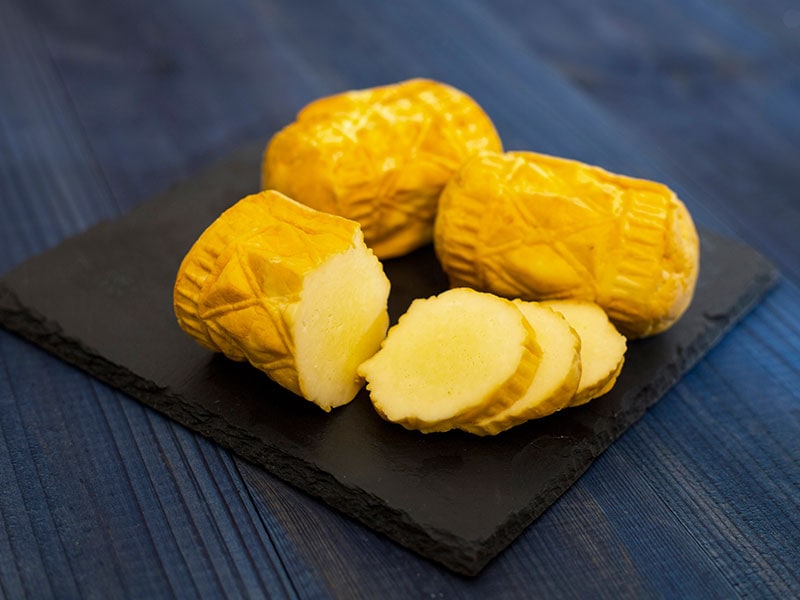
On the slopes of Poland’s Tatra Mountains, a special cheese known as Oscypek is made. This is no ordinary cheese; Oscypek has a salty and slightly sour flavor made from salted sheep milk. And it’s famous for its distinct smoky flavor, which comes from being smoked over a fire.
When pan-fried or grilled, Oscypek’s character deepens, revealing subtle hints of chestnuts in its complex flavor profile.
Served as a traditional Polish food, it’s my favorite when accompanied by cranberry marmalade or cranberry jam (żurawina). This combination enhances the cheese’s mildly piquant taste, creating an unforgettable culinary adventure.
United Kingdom
77. Cornish Pasty
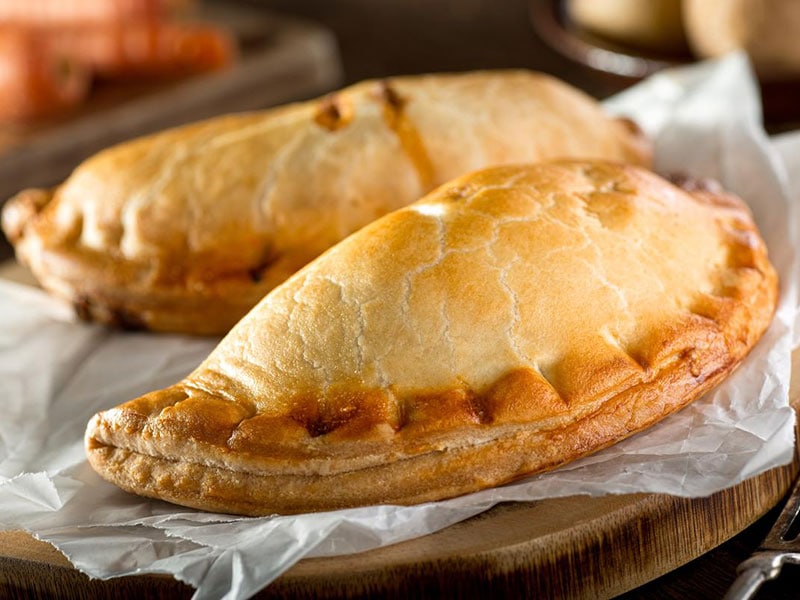
Cornwall, South West England, is the birthplace of the classic British Pasty. This baked pastry, protected by Geographical Indication status since 2011 [3], began as a handy lunch for Cornish tin miners, fishermen, and farmers.
Its popularity soon spread across the British Isles, with this snack becoming a favorite on the streets. Some varieties are sweet, but it is typically savory.
In its most traditional form, the pasty cradles a filling of beef, sliced potato, and swede, achieving a beautifully balanced, savory taste. Nowadays, the pasty’s versatility sees it housing an endless range of delicious fillings.
78. Fish & Chips
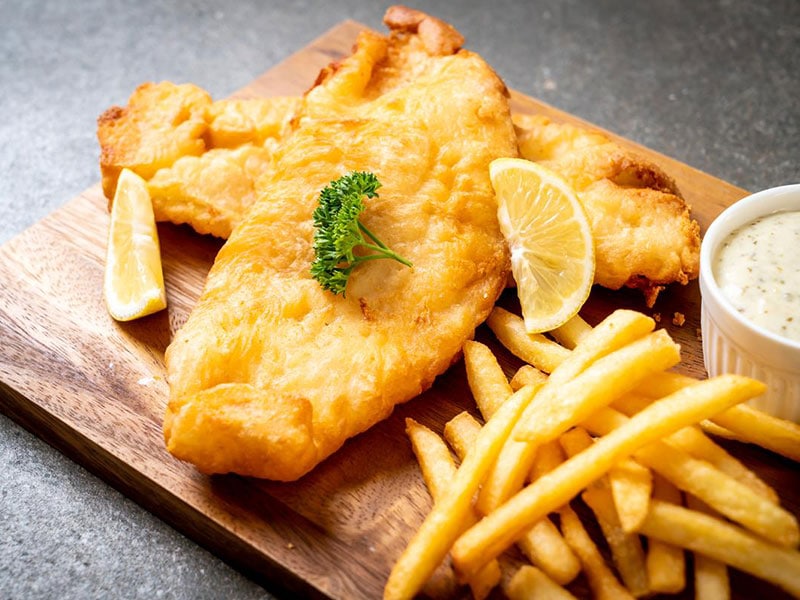
As a true English classic, fish & chips have won the title of Britain’s national dish. Deep-fried, golden fish, encased in a crispy batter, sits side by side with French fries.
Nowadays, this dish is a familiar face in takeaway and street food scenes across Europe and beyond. To complete the taste sensation, a drizzle of tartar sauce or a favorite condiment.
79. Black Pudding
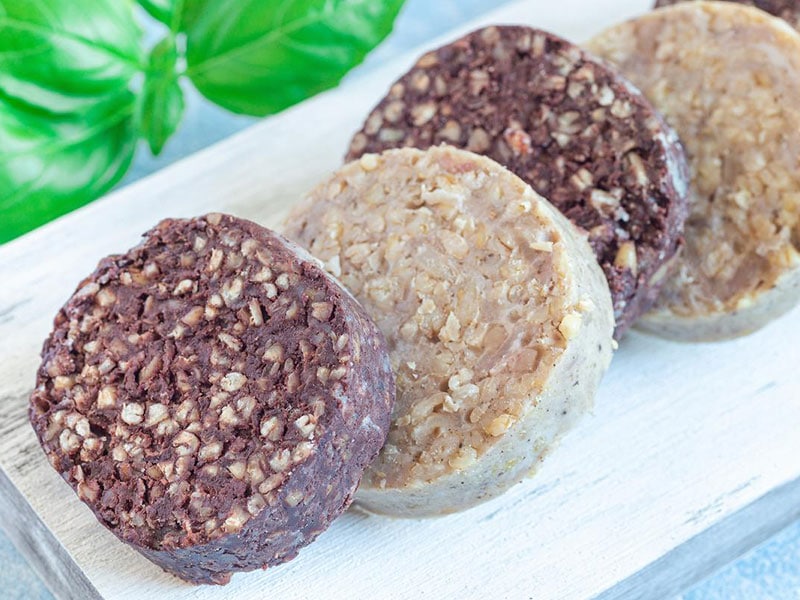
Originating from the United Kingdom and Ireland, black pudding is a regional variant of blood sausage. It incorporates pork or beef blood, pork fat or beef suet, and a choice of cereal – typically oatmeal, oat groats, or barley groats.
Specific herbs, pennyroyal being one, give this hearty food its distinct taste, separating it from other global blood sausages.
Flexible in its serving options, it can be grilled, fried, baked, or even boiled on its skin. Plus, this sausage comes fully cooked straight from production, making it an option for a cold snack too.
80. Jellied Eels
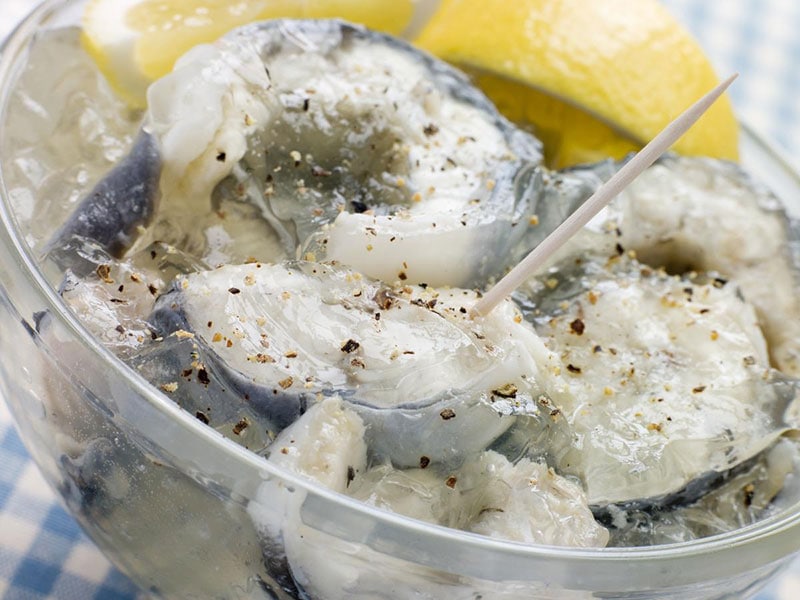
Jellied eels, a true Cockney street food staple, have been charming taste buds since the 18th century. This dish comprises chopped European eels, native to Britain, boiled in a spiced stock, which then cools and sets into a jelly.
The stock is a blend of water and vinegar, enhanced with nutmeg and lemon juice. Once cool, these eels are typically served cold. For serving, chili vinegar or a mix of malt vinegar and white pepper are ideal additions.
For a full traditional East End experience, locals often pair it with pie and mash.
81. Scotch Eggs
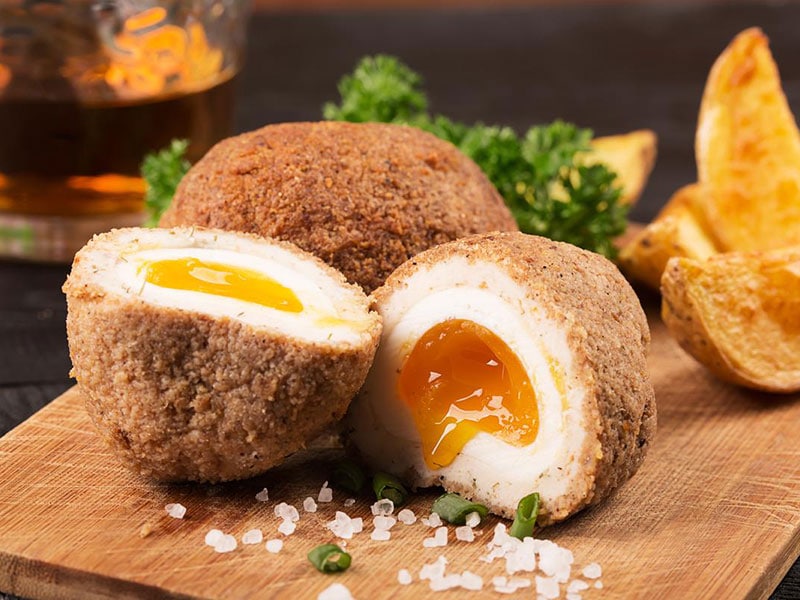
In the world of comfort food, Scotch eggs reign supreme. As a boiled egg ensconced in sausage meat, then coated in breadcrumbs and baked or deep-fried.
Whether you’re savoring one in a cozy pub, at a picnic, or as a street-food snack, its versatile nature is captivating. The beauty of this treat is that it can be relished hot or cold. To me, it’s at its best when it’s chilled and paired with pickles and a crisp salad.
In Ireland
82. Spice Bag
Spice Bag is the ultimate fast food blend with a strong hint of Chinese inspiration. It has become the star in most Irish Chinese takeaways.
This Irish street delicacy is a sizzling mix of deep-fried salt and chili chips, shredded salt and chili chicken, fried onions, red and green peppers, chili peppers, and spices.
For the plant-based crowd, there’s usually a vegetarian or vegan version available. In 2020, this fusion dish was voted ‘Ireland’s Favourite Takeaway Dish’ in the Just Eat National Takeaway Awards [4].
83. Chicken Fillet Roll
Chicken filet roll, also called hot chicken roll or shortened as chicken roll, is a top deli food in Ireland. It’s a baguette filled with breaded and fried chicken, coupled with a dollop of mayonnaise or butter.
They’re sold just about everywhere, from petrol stations, newsagents, and convenience shops to fast food restaurants, casual eateries, and supermarkets. Surprisingly, they’re famously good for a hangover!
To add more flavors and texture, other condiments like onion, potato wedges, lettuce, cheese, or stuffing, are common choices.
Iceland
84. Skyr

Skyr is an age-old gem from Icelandic cuisine + (Icelandic foods). This cultured dairy product has a comforting mildness to it, smoother than the tangy zing of most yogurts.
Some call it a fresh sour milk cheese. It has the same consistency, and it is eaten in the same way as yogurt in countries, such as the Baltic states, the Low Countries, Germany, or Russia.
There’s this lovely hint of sweetness that lingers after the initial slightly sour dairy flavor, making it refreshing when served cold, with or without cream. Good news, they are conveniently available in most supermarkets.
85. Icelandic Hot Dog
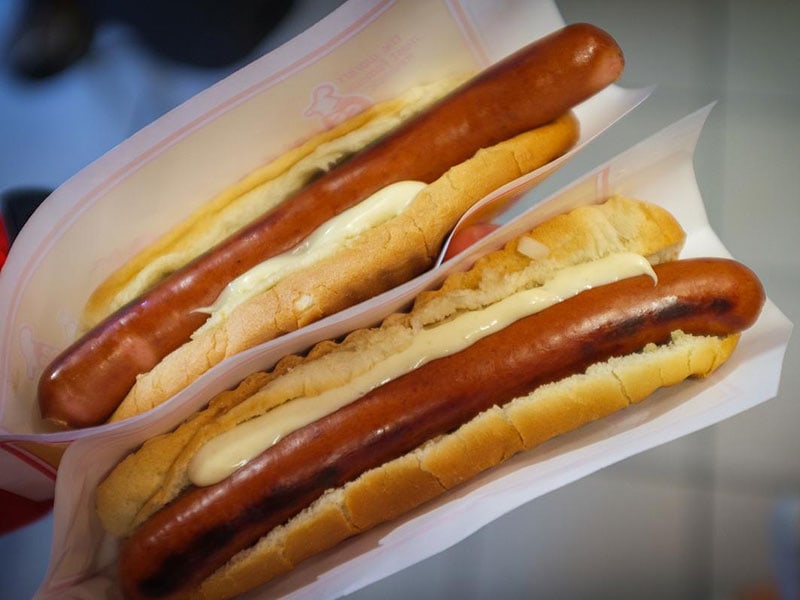
An Icelandic hot dog, commonly recognized as a representation of Icelandic street cuisine. As an easy-to-find staple, it is a blend of lamb, pork, and beef snugly nestled in a warm steamed bun. I love its unique appeal, where toppings like raw white onions, crispy fried onions, ketchup, and sweet brown mustard create a balanced symphony of flavors.
From bustling city hot dog stands to quiet village convenience stores, and even at the airport, these humble hot dogs assert their culinary presence.
Switzerland
86. Fondue
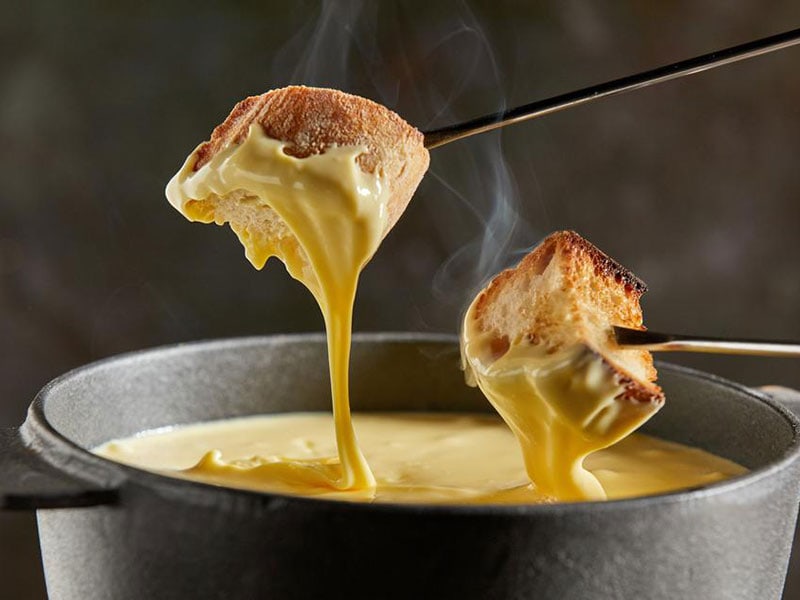
Fondue is a cozy ensemble of melted cheese and wine. As a fan, I’ve relished dipping bread using long-stemmed forks into a communal pot called caquelon or the fondue pot, which is usually set over a portable stove, heated by a spirit lamp or a candle.
This has been a cherished culinary delight of Switzerland, especially during cold months. Fondue’s status was elevated to a national dish by the Swiss Cheese Union ((Schweizerische Käseunion) in the 1930s [5].
Now, this molten cheese wonder has become a street food superstar in Switzerland and is also widely relished in France and Italy.
87. Bündner Nusstorte (Swiss Walnut Cake)
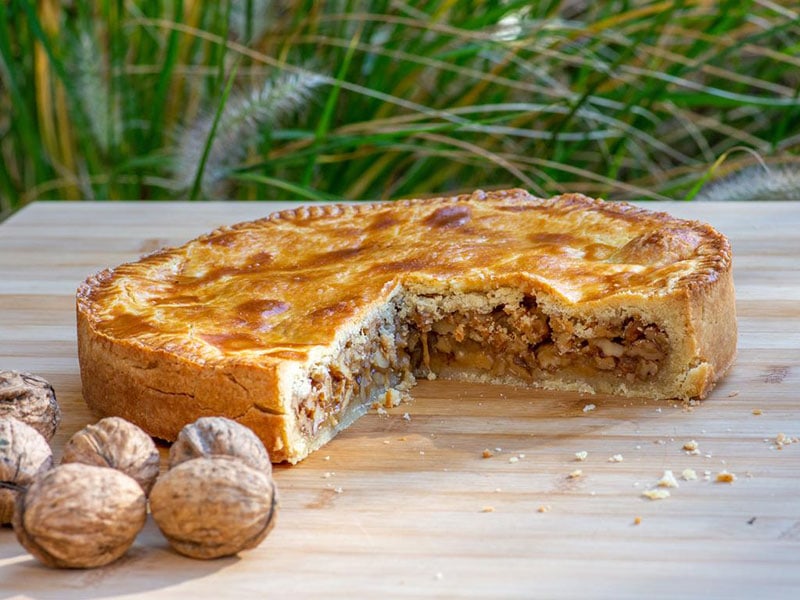
Bündner Nusstorte, or Engadiner Nusstorte, is a sweet walnut cake from Graubünden in Switzerland. This pastry is a melody of caramelized nuts, mostly walnuts, and sugar.
With each bite, you can taste its rich, crunchy texture. Each time I wander on street food markets, these Swiss sweet treats are always my go-to choice for a simple snack or dessert.
Other
88. Socca (Chickpea Flatbread) – France, Monaco
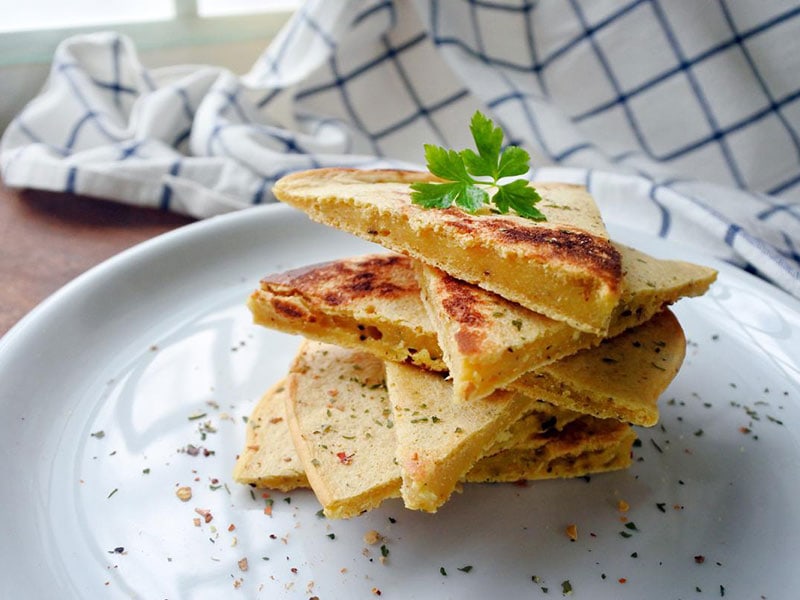
Socca, with its origin in Genoa, has left an indelible mark on my food explorations. This dish, similar to a thin crepe, carries the unique twist of being made with chickpea flour.
Indeed, it’s a familiar sight in the southeastern parts of France, especially around the Cours Saleya market in Nice. On the other hand, its popularity rapidly rose across Southern France and Monaco, where it’s now a beloved street food snack.
89. Gromperekichelcher (Potato Fritters) – Luxembourg
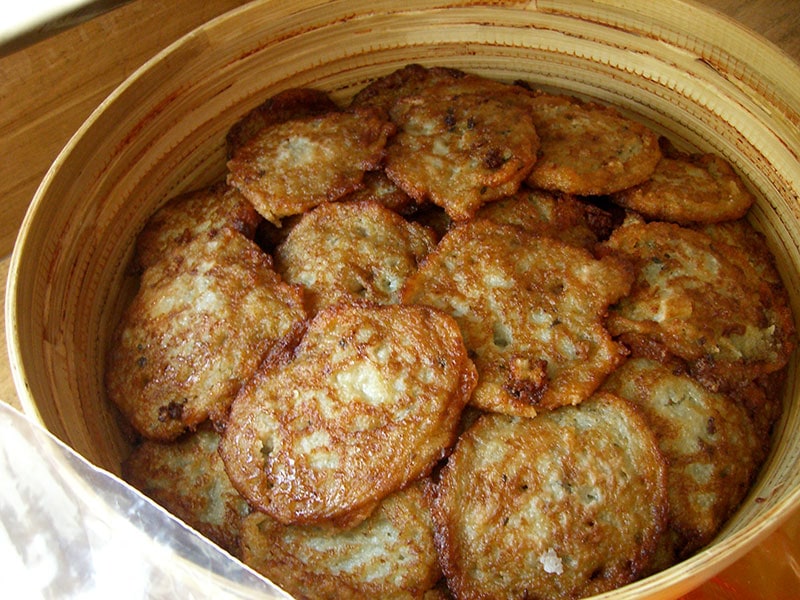
Gromperekichelche is a name that brings back memories of crowded Christmas markets in Luxembourg. In fact, it originally hails from Germany/Austria.
These delicious fritters are a beautiful mix of onions, eggs, flour, and parsley. Served warm, they pair wonderfully with apple compote or even with simple ketchup or chutney. So grab a bite, its crispy exterior and fluffy inside will surprise you.
90. Smørrebrød (Open-Faced Sandwiches) – Denmark, Norway, Sweden
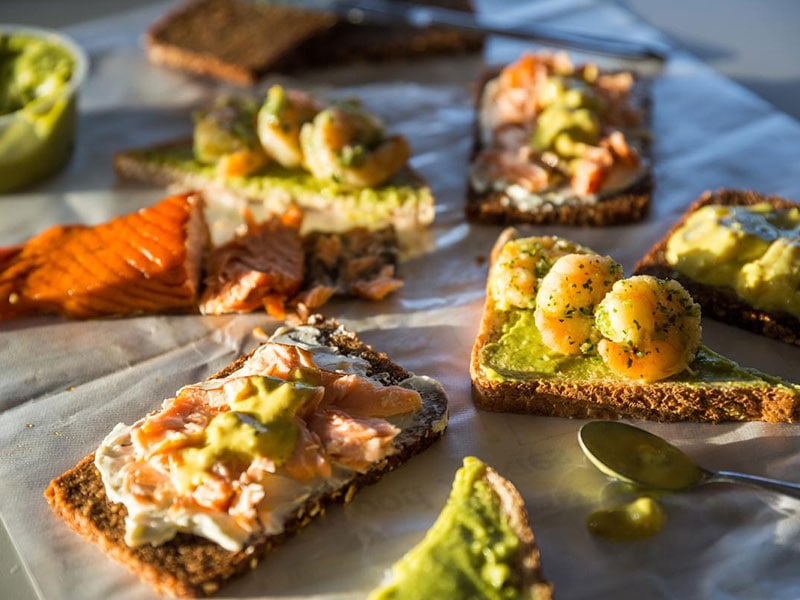
Here is a masterpiece from the kitchens of Denmark, Norway, and Sweden – Smørrebrød. This is a traditional open-faced sandwich that has won me over every time.
It usually begins with a simple slice of buttered rye bread. But it’s the toppings that truly make it special – from cold cuts, meats, or fish, to cheeses, spreads, and even garnishes.
You can find them in supermarkets or in traditional Danish restaurants. I still recall my first time trying them at Hallernes Smørrebrød, which I highly recommend.
These sandwiches play an essential part during holiday festivities like Christmas and Easter. But Denmark isn’t alone in this; Austria, for instance, has its version called Belegte Brote.
91. Lefse (Potato Flatbread) – Norway
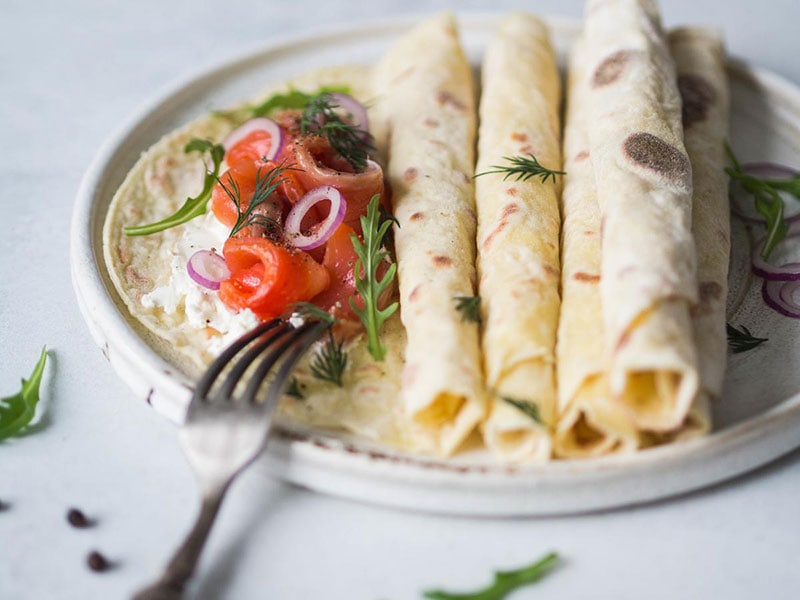
Lefse is a soft Norwegian flatbread with a unique flavor and texture. Flour forms the base, while riced potatoes, butter, milk, cream, and sometimes lard join in to create this beloved snack.
Cooked on a flat griddle, it rules the streets of Oslo and is a crucial part in Scandinavian food culture. Lefse mirrors the French crêpe in appearance, yet bursts with the rich, buttery essence of baked potatoes.
And yes, it’s a Christmas staple too! Roadside snack bars and coffee shops across Norway truly wouldn’t be the same without the humble Lefse.
92. Kiluvõileib (Sprat Sandwich) – Estonia
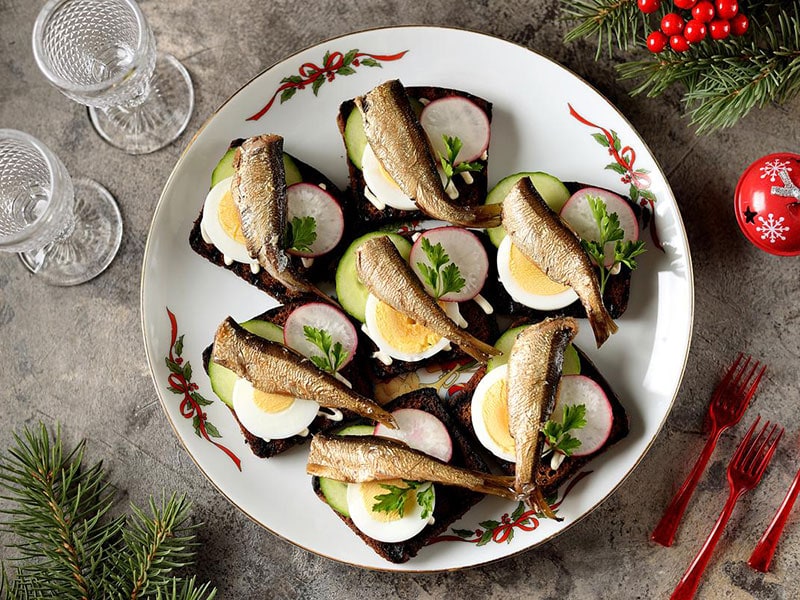
In the heart of the Baltic Sea, sprats swim aplenty, and one dish where they truly star is in the Kiluvõileib. This sandwich starts with a slice of rye bread, which then cradles a marinated sprat filet.
A buttery layer, or even munavoi, enriches the base, while the sprat filets might be accompanied by eggs, either poached or hard-boiled, green onions, and fresh herbs.
The first time I had this at a local restaurant, the distinct taste captivated me, and now, it’s hard to miss at any festive occasion I attend.
93. Piragi (Bacon Buns) – Latvia
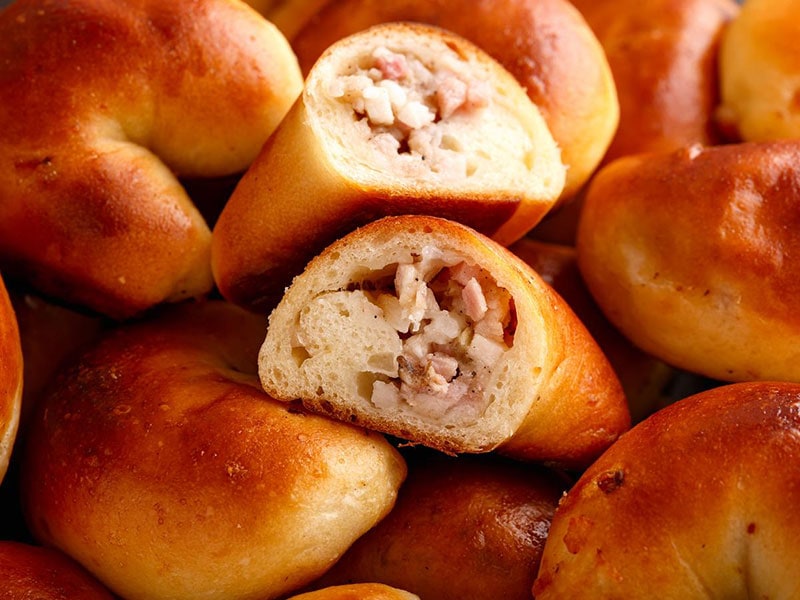
Charming Baltic state in Latvia is the root of the famous street food, Piragi. These are delicious buns filled with a hearty stuffing of bacon and chopped onions.
In the past, these were specially made for big celebrations – birthdays, Christmas, or summer festival of Jāņi. Today, these mouth-watering snacks are readily available for you to savor.
Whether you’re wandering through bustling street food stalls or stepping into cozy local bakeries, you’re likely to come across Piragi.
94. Kibinai (Lithuanian meat pie) – Lithuania
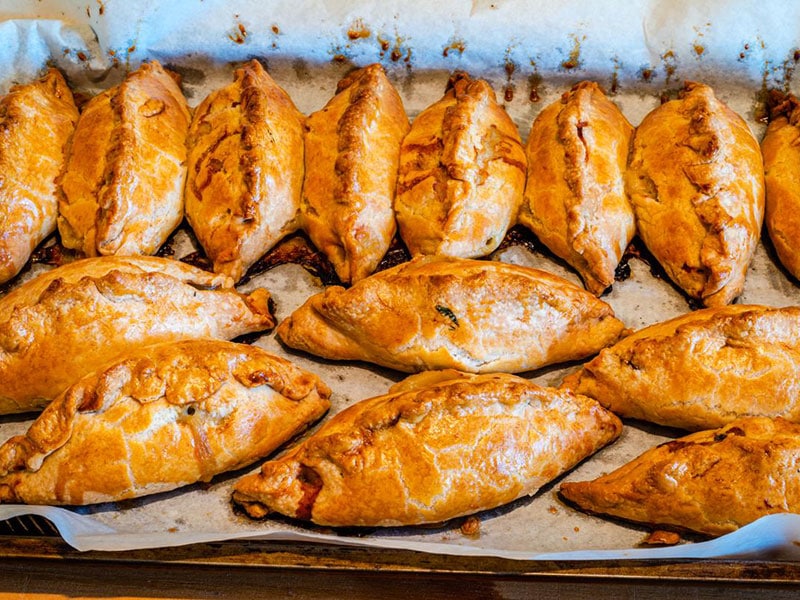
Kibinai is a popular Lithuanian snack, similar to the renowned Piragi of Latvia. This snack takes a delicious twist by swapping out bacon for mutton, making it less greasy but enhancing its texture significantly.
I’ve had the pleasure of savoring Kibinai in different settings, and let me assure you, it shines as both a main dish and a snack. The beauty of it lies in its versatility, as it retains the delightful taste, whether served hot or cold.
95. Banitsa (Cheese Pie) – Bulgaria
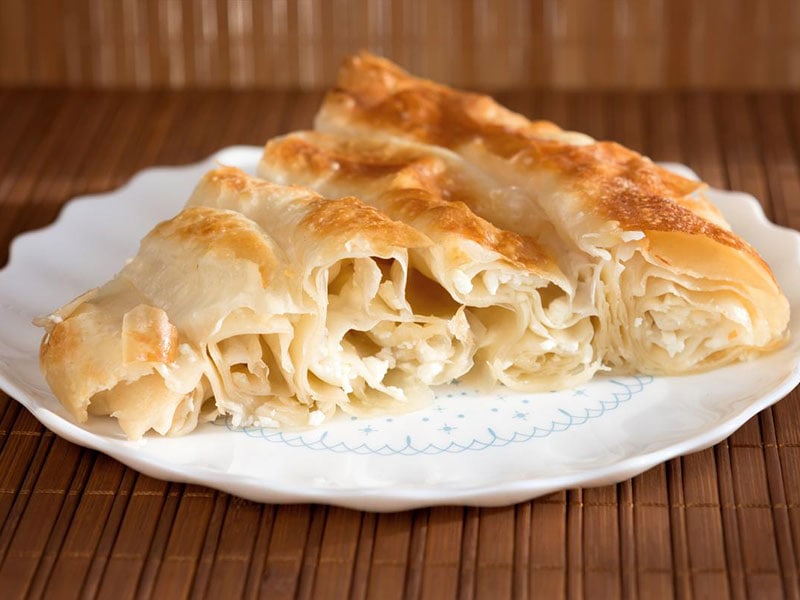
Banitsa, also known as banica or banitza, is a specialty from Bulgaria, North Macedonia, and Southeastern Serbia. Its creation involves a meticulous process of layering filo pastry with a generous mixture of whisked eggs, natural yogurt, and chunks of white brined cheese.
Once it’s assembled, it heads for a hot oven, emerging as a gloriously golden pastry masterpiece. When breakfast rolls around in Bulgaria, Banitsa reigns supreme on dining tables, its flaky texture and salty cheese filling.
It brings to mind the love child of a pie and a burek, versatile in its potential fillings. While cheese is the classic choice, other versions are filled with spinach, egg, meat, or even sweet milk.
Commonly, the bustling streets of Bulgaria are dotted with small bakeries serving this beloved fast food.
96. Petulla (Soft Fried Dough) – Albania
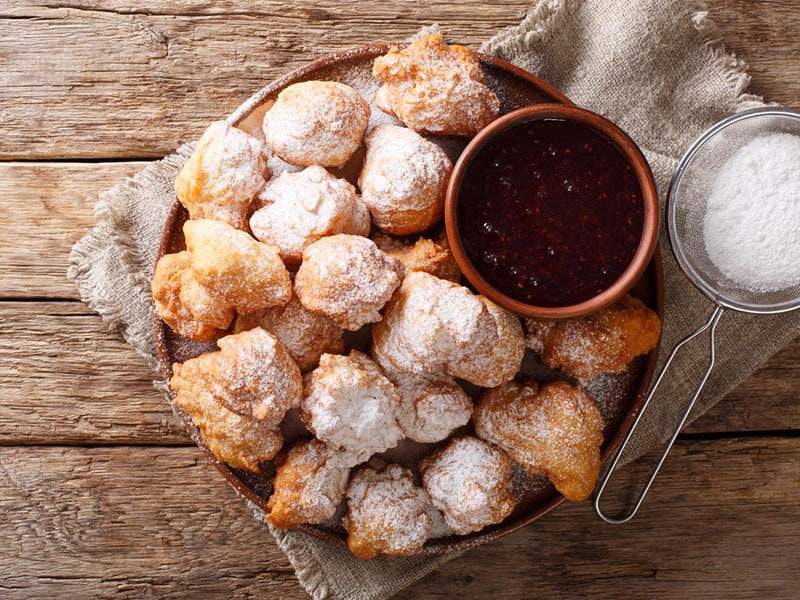
In Albanian cuisine, Petulla is a simple, doughnut-like snack that stands as a cherished symbol of local gastronomy. This delight begins its journey with a humble mix of flour, yeast, eggs, and milk.
The dough is then fried until a crispy, golden exterior encases a soft, melt-in-your-mouth interior. This textural contrast is one of Petulla’s defining traits that locals and tourists can’t get enough of.
The dish elevates its allure further with the two most popular toppings: decadent hot chocolate and a dusting of powdered sugar.
Early mornings in Albanian coffee shops are incomplete without a serving of Petulla, and it’s not uncommon to see it being sold at numerous street food stalls in cups. Stroll along the beach, and you may come across vendors peddling Petulla, topped with a rich chocolate sauce.
97. Njeguški Pršut / Njeguska Prsuta (Smoked Ham) – Montenegro
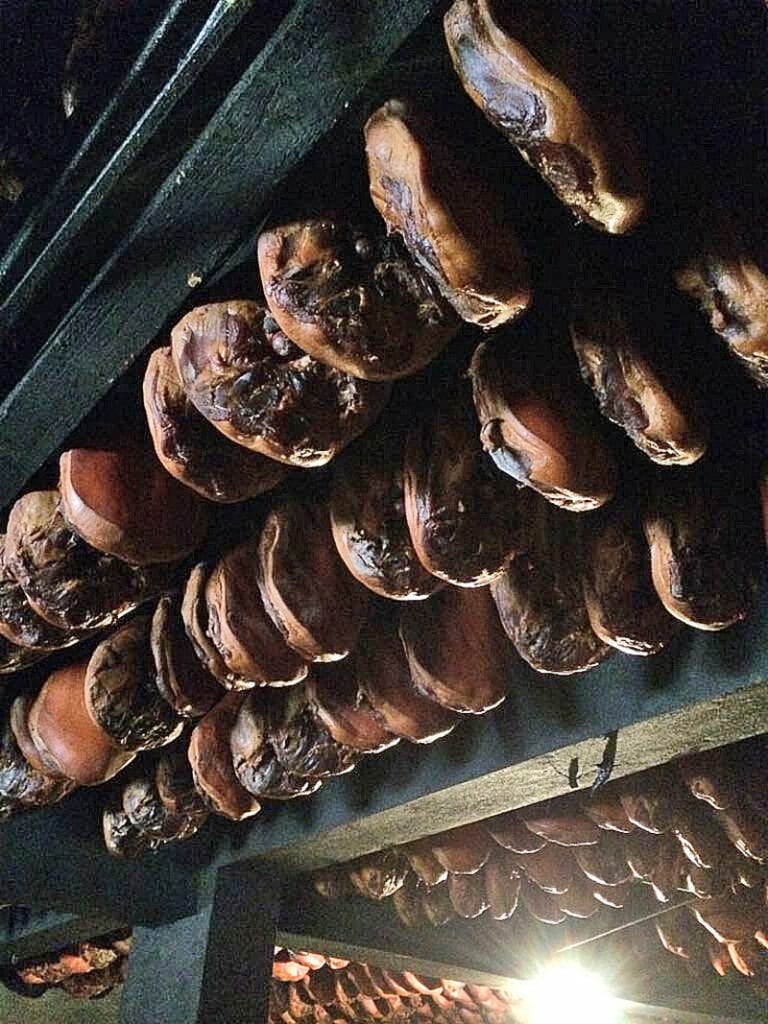
Within the picturesque village of Njeguši in Montenegro, a culinary tradition thrives. It is Njeguški Pršut, a dry-cured ham that’s simply phenomenal.
This isn’t your average ham. You might draw comparisons with the Italian prosciutto crudo, but trust me, Njeguški Pršut carries its own character. Its flavor and aroma reflect its special preparation process.
This signature Montenegrin delicacy is salted with sea salt for roughly three weeks, then pressed to expel excess liquid for a similar period. The next steps are what make this ham genuinely stand out. It undergoes light smoking, during which beech wood is burned, infusing the meat with a sublime smokiness.
Then, it dries in the cool mountain breeze for three months, inheriting the soul of Montenegro’s natural beauty. A maturing process follows, and the whole cycle culminates in a year. Despite Njeguški Pršut being a product of this tiny village, it has spread its wings across the country.
You can locate it in supermarkets, packaged in meat shops, or even on street food stalls. My personal favorite? Having it in a sandwich, coupled with fresh local bread and cheese.
98. Leskovacki Rostilj – Serbia
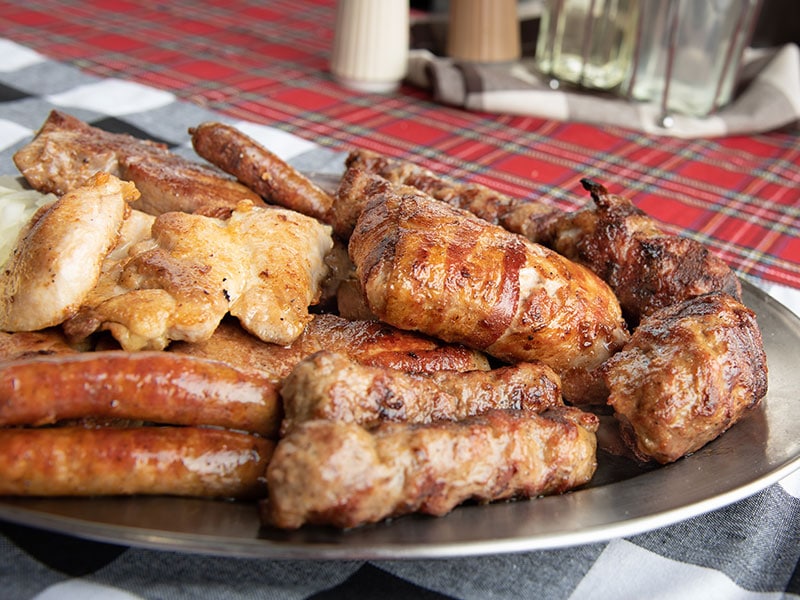
In the small Serbian town of Leskovac, barbecue isn’t just about food – it’s about tradition, culture, and national pride. As someone who has savored Leskovac barbecue, I can affirm its uniqueness.
The Leskovac barbecue, or Leskovacki Rostilj, is an exquisite blend of different types of barbecued meat, spiced up with local spicy paprika powder. The exact preparation of this delicacy remains a closely guarded secret known only to Leskovac barbecue masters.
Street food stalls and fast food shops across Serbia and Macedonia serve it, and each bite embodies the regional culinary flair. To truly understand the significance of Leskovac barbecue, note the annual Roštiljijada, a festival held in Leskovac every September to celebrate it.
The local pride is so strong that Leskovac barbecue has officially become a protected regional brand in Serbia.
99. Burek – Bosnia and Herzegovina
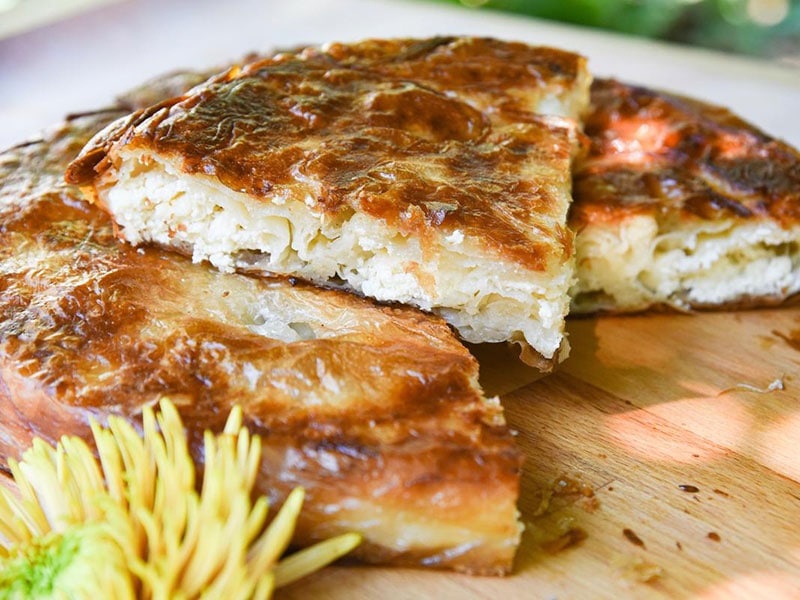
Burek is the beloved street food and breakfast staple in the Balkan region (such as Bosnia, Croatia, and Serbia). It’s the warm and golden, crispy layers of thin dough filled mostly with ground beef that always catch my attention.
It’s not just about the flavor but also the variety of shapes and sizes. Even though ground beef is the traditional filling, one of the beautiful things about Burek is its diversity. There’s Sirnica, filled with cottage cheese, Zeljanica with spinach, and Krompiruša featuring potatoes.
100. Štruklji (Cheese Dumplings) – Slovenia
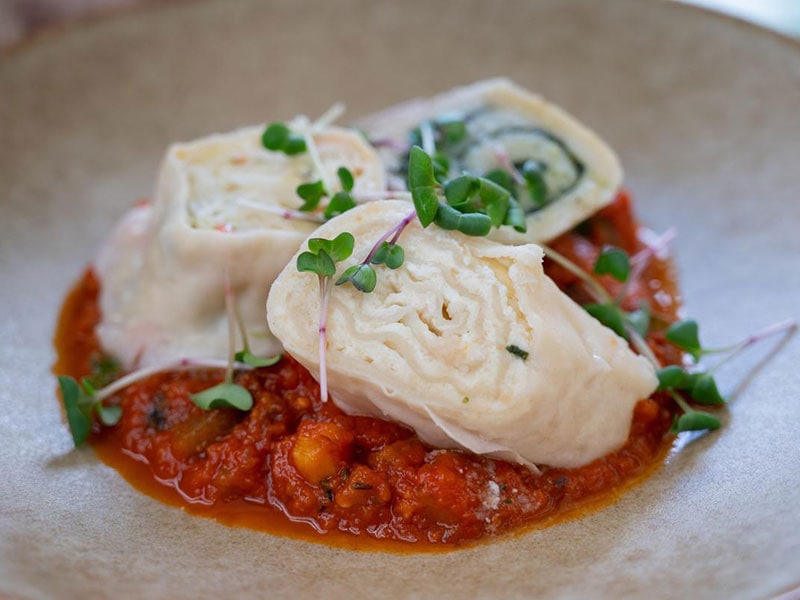
In Slovenia, Štruklji (aka cheese dumplings) holds a special place. These rolled dumplings comprise dough and a range of fillings, with methods of preparation including deep-frying, steaming, boiling, and baking.
One of the most notable variations that I have savored is the cheese filling imbued with tarragon and chives. The harmonious blend of herbs coupled with the creamy cheese, all within the soft dough, yields an exceptional gastronomic experience.
Beyond the cheese variation, Štruklji filled with meat and gravy or apples and walnuts are also ideal alternatives.
Although historically associated with special occasions, Štruklji has seamlessly transitioned into an everyday dish in Slovenia, prevalent in households, bakeries, and street food stalls. The ubiquity of this dish can also have a close connection to Zagorski štruklji, a traditional Croatian dish.
101. Covrigi – Romania
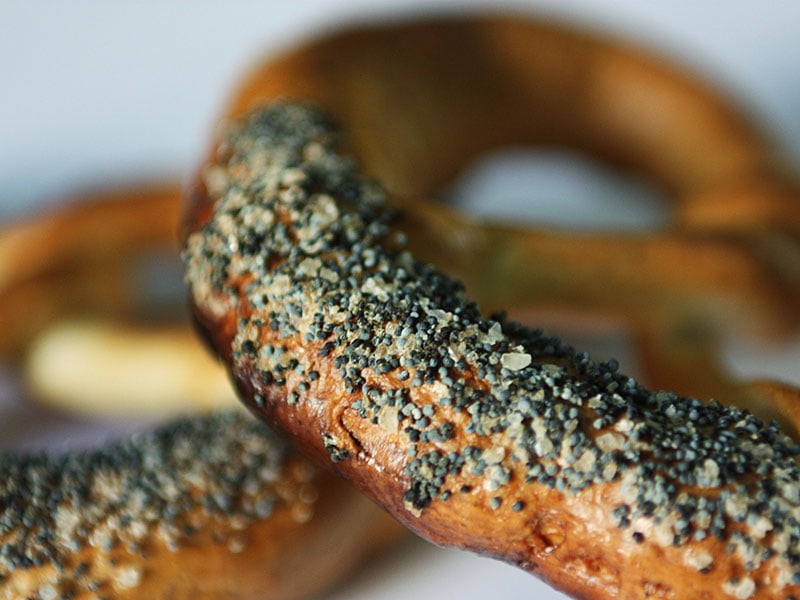
In Romania, there’s a fantastic baked good called Covrigi. When wandering the urban streets, you can’t help but notice a plethora of street vendors selling these savory bread treats.
Similar to a pretzel, they’re baked with care, and topped with sesame seeds, poppy seeds, or large salt grains – a blissful symphony of textures to the tongue. There’s no sugar added, either!
Buzău City is a famous place to enjoy authentic Covrigi. What really fascinated me was the diverse assortment available. Think sausage-filled Covrigi, cheese-filled ones, or those stuffed with apples or even chocolate. There are also some unfilled, seed-topped versions!
Moreover, these bread are goodies during the holiday season. They’re not just snacks anymore; they’re an integral part of the festive spirit, beautifully packaged and given as holiday gifts in rural areas.
102. Plăcintă (Cheese Pies) – Romania, Moldova
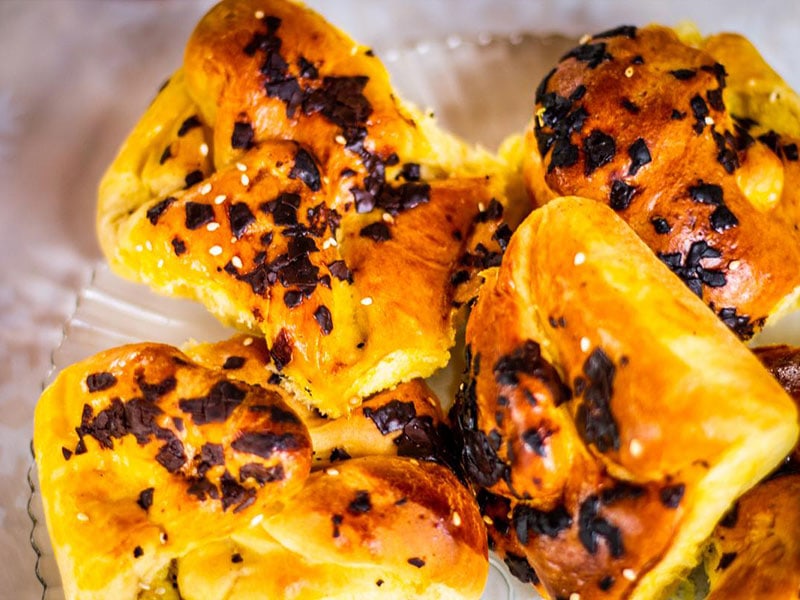
Plăcintă is a thin, small cake. It is a traditional gem treasured in both Romania and Moldovan cuisine. Whether round or square, each bite of this pastry promises a rich experience.
Common fillings like soft Urdă cheese or apples are delightful, but there’s also a world of other fillings to explore – from sheep or cow cheese to potatoes, raisins, and even chocolate.
My fondness for Plăcintă grew during my time in Chisinau. The pastry is as integral to the city’s streets as the vibrant life that buzzes around it. Its reach extends beyond Moldova, gracing the shelves of numerous convenience stores across the country and Romania too.
Top 10 Street Food Capitals of Europe
- Rome, Italy: Italy’s capital is renowned for its vibrant street food scene. Local delights include Supplì (deep-fried rice balls) and sandwiches with Porchetta (boneless pork roast).
- Berlin, Germany: Berlin is a melting pot of different cultures and cuisines. Currywurst, grilled sausage served with curry ketchup, and Döner Kebab, a Turkish dish that has been adapted to German tastes, are among the city’s most beloved street foods.
- Istanbul, Turkey: Straddling Europe and Asia, Istanbul’s street food is a delicious blend of both continents. Stalls sell everything from Simit (sesame-encrusted bread rings) to Balık Ekmek (fish sandwiches), and kebab.
- London, UK: London’s diverse population means its street food scene is equally varied. Borough Market and other food markets throughout the city offer a myriad of choices, from traditional British pies to Indian curries, Mexican tacos, and much more.
- Paris, France: In Paris, street food often comes with a gourmet touch. Crêpes, croissants, baguettes, and pastries are common on the streets of this beautiful city.
- Madrid, Spain: Madrid is famous for its tapa culture. In open-air markets and food stalls, you can find everything from Bocadillos de Calamares (squid sandwiches) to Churros con Chocolate (fried dough with hot chocolate).
- Athens, Greece: Known for its delicious and healthy Mediterranean cuisine, Athens’ street food has nothing to disappoint. Souvlaki (grilled meat skewers), gyros (grilled meat wrapped in a pita), and Spanakopita (spinach pie) are just a few examples.
- Copenhagen, Denmark: Copenhagen’s street food scene is a mix of traditional and modern. The traditional delight is Smørrebrød (open-faced sandwiches), but you can visit international food stalls at markets like Reffen for more options.
- Budapest, Hungary: Hungarian street food is hearty and flavorful. Lángos (deep-fried flatbread), Kürtőskalács (chimney cake), and various types of sausages are among the street foods you can find in Budapest.
- Amsterdam, Netherlands: Amsterdam’s street food is a reflection of its maritime history. Haringhappen (raw herring), Stroopwafel (two thin waffles with caramel syrup in between), and Frites (fries) served with a variety of sauces are all popular choices.
FAQs
European Street Food: A Taste Bud Adventure
European street foods truly have a story of their own, don’t they? Bursting with flavors, these treats give people a delectable glimpse into the continent’s rich cultural tapestry.
And that’s what makes each bite all the more intriguing. I hope you’ve enjoyed this culinary tour as much as I have. So go ahead, give the article a like, share it with fellow food enthusiasts, and leave a comment on your favorite street food!
References
- Only a few people in the world know how to make this Portuguese pastry (2016) The World from PRX.
- Stroopwafel (no date) Encyclopædia Britannica.
- Cornish pasty name given European Protected Status (2011) BBC News.
- Falvey, D. (2020) Ireland’s favourite takeaway revealed, The Irish Times.
- Zaino, C. (2022) Tracing fondue’s mysterious origins, BBC Travel.

